Financial Accounting Principles Solved Assignment
VerifiedAdded on 2021/01/03
|27
|6978
|29
AI Summary
Contribute Materials
Your contribution can guide someone’s learning journey. Share your
documents today.
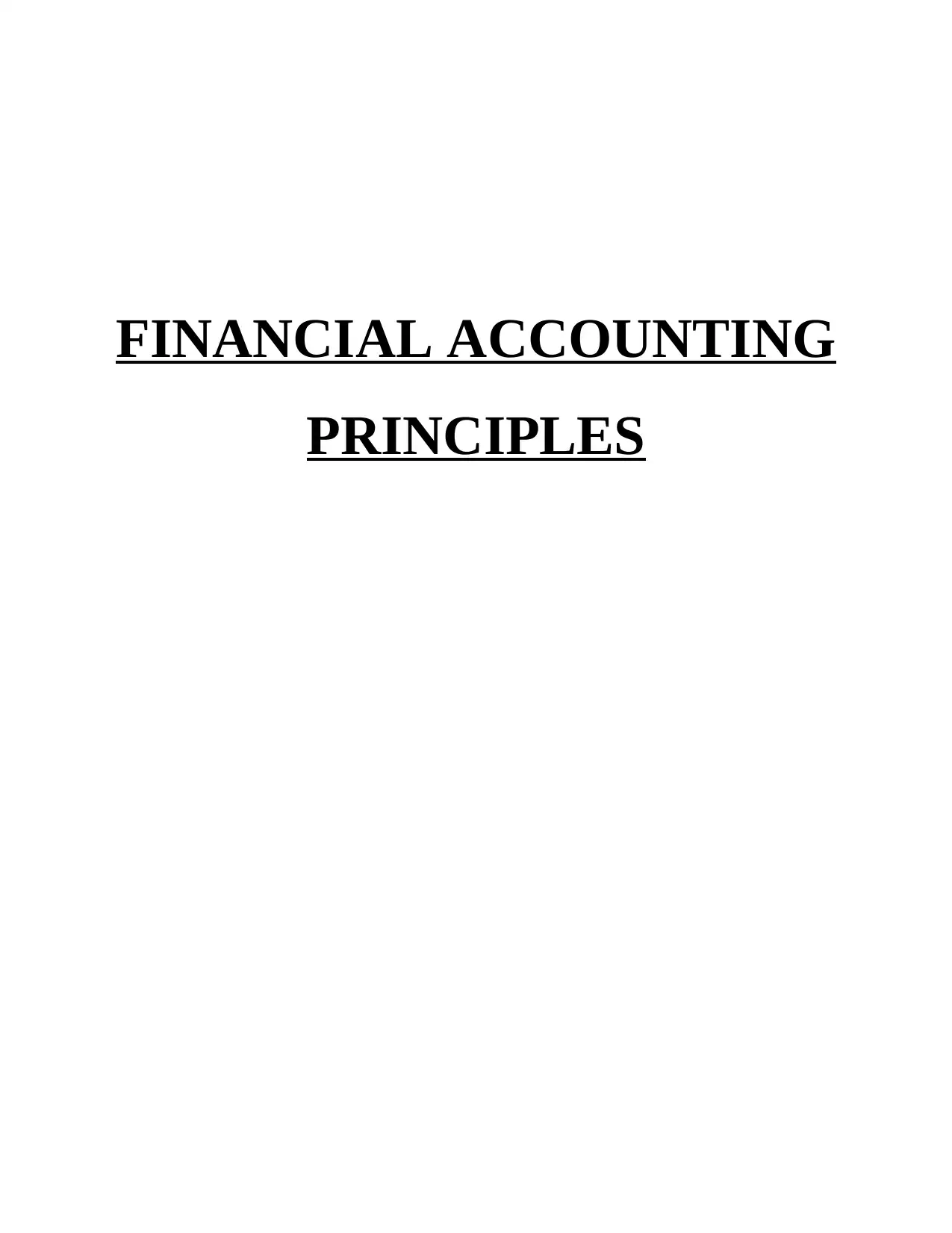
FINANCIAL ACCOUNTING
PRINCIPLES
PRINCIPLES
Secure Best Marks with AI Grader
Need help grading? Try our AI Grader for instant feedback on your assignments.
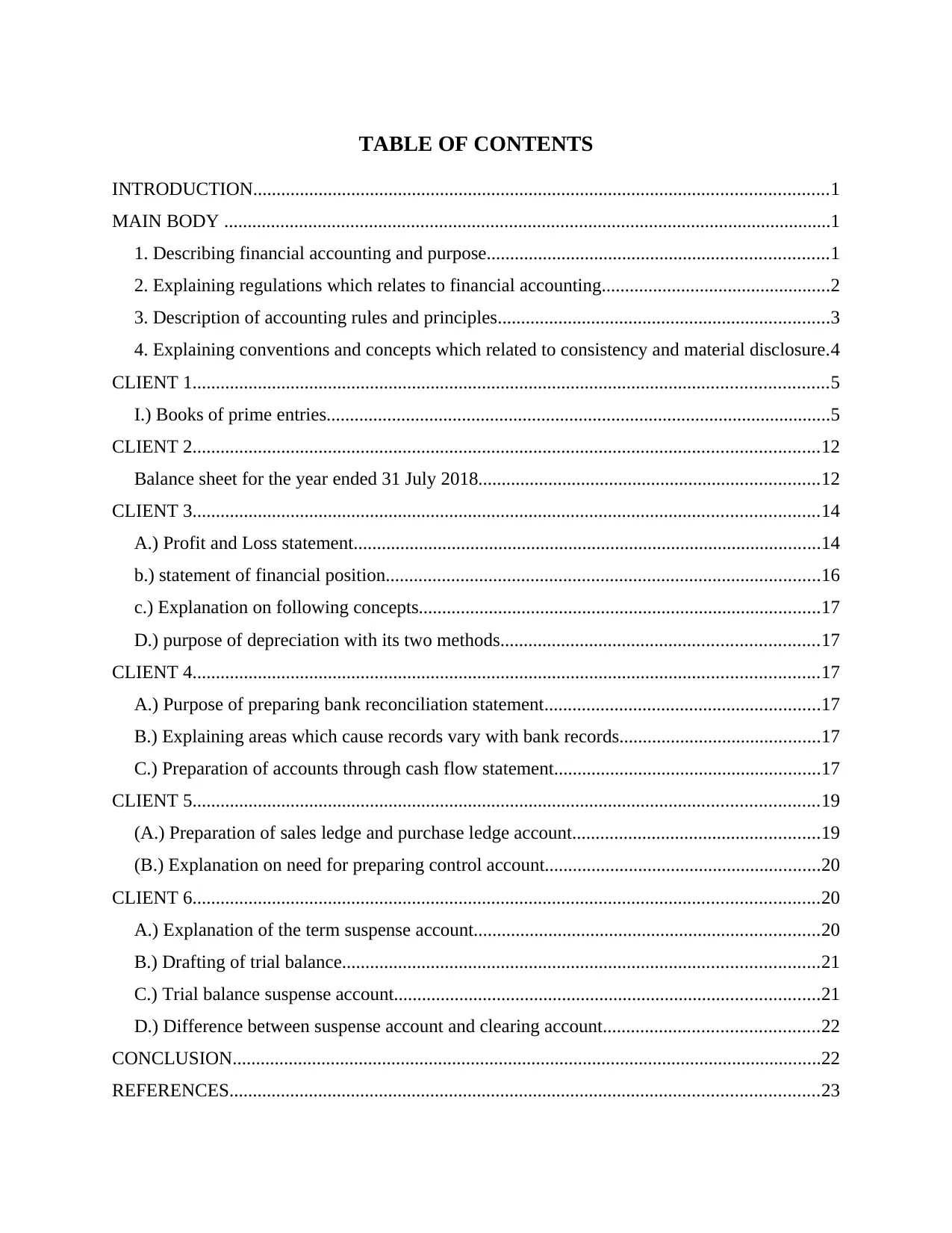
TABLE OF CONTENTS
INTRODUCTION...........................................................................................................................1
MAIN BODY ..................................................................................................................................1
1. Describing financial accounting and purpose.........................................................................1
2. Explaining regulations which relates to financial accounting.................................................2
3. Description of accounting rules and principles.......................................................................3
4. Explaining conventions and concepts which related to consistency and material disclosure.4
CLIENT 1........................................................................................................................................5
I.) Books of prime entries............................................................................................................5
CLIENT 2......................................................................................................................................12
Balance sheet for the year ended 31 July 2018.........................................................................12
CLIENT 3......................................................................................................................................14
A.) Profit and Loss statement....................................................................................................14
b.) statement of financial position.............................................................................................16
c.) Explanation on following concepts......................................................................................17
D.) purpose of depreciation with its two methods....................................................................17
CLIENT 4......................................................................................................................................17
A.) Purpose of preparing bank reconciliation statement...........................................................17
B.) Explaining areas which cause records vary with bank records...........................................17
C.) Preparation of accounts through cash flow statement.........................................................17
CLIENT 5......................................................................................................................................19
(A.) Preparation of sales ledge and purchase ledge account.....................................................19
(B.) Explanation on need for preparing control account...........................................................20
CLIENT 6......................................................................................................................................20
A.) Explanation of the term suspense account..........................................................................20
B.) Drafting of trial balance......................................................................................................21
C.) Trial balance suspense account...........................................................................................21
D.) Difference between suspense account and clearing account..............................................22
CONCLUSION..............................................................................................................................22
REFERENCES..............................................................................................................................23
INTRODUCTION...........................................................................................................................1
MAIN BODY ..................................................................................................................................1
1. Describing financial accounting and purpose.........................................................................1
2. Explaining regulations which relates to financial accounting.................................................2
3. Description of accounting rules and principles.......................................................................3
4. Explaining conventions and concepts which related to consistency and material disclosure.4
CLIENT 1........................................................................................................................................5
I.) Books of prime entries............................................................................................................5
CLIENT 2......................................................................................................................................12
Balance sheet for the year ended 31 July 2018.........................................................................12
CLIENT 3......................................................................................................................................14
A.) Profit and Loss statement....................................................................................................14
b.) statement of financial position.............................................................................................16
c.) Explanation on following concepts......................................................................................17
D.) purpose of depreciation with its two methods....................................................................17
CLIENT 4......................................................................................................................................17
A.) Purpose of preparing bank reconciliation statement...........................................................17
B.) Explaining areas which cause records vary with bank records...........................................17
C.) Preparation of accounts through cash flow statement.........................................................17
CLIENT 5......................................................................................................................................19
(A.) Preparation of sales ledge and purchase ledge account.....................................................19
(B.) Explanation on need for preparing control account...........................................................20
CLIENT 6......................................................................................................................................20
A.) Explanation of the term suspense account..........................................................................20
B.) Drafting of trial balance......................................................................................................21
C.) Trial balance suspense account...........................................................................................21
D.) Difference between suspense account and clearing account..............................................22
CONCLUSION..............................................................................................................................22
REFERENCES..............................................................................................................................23
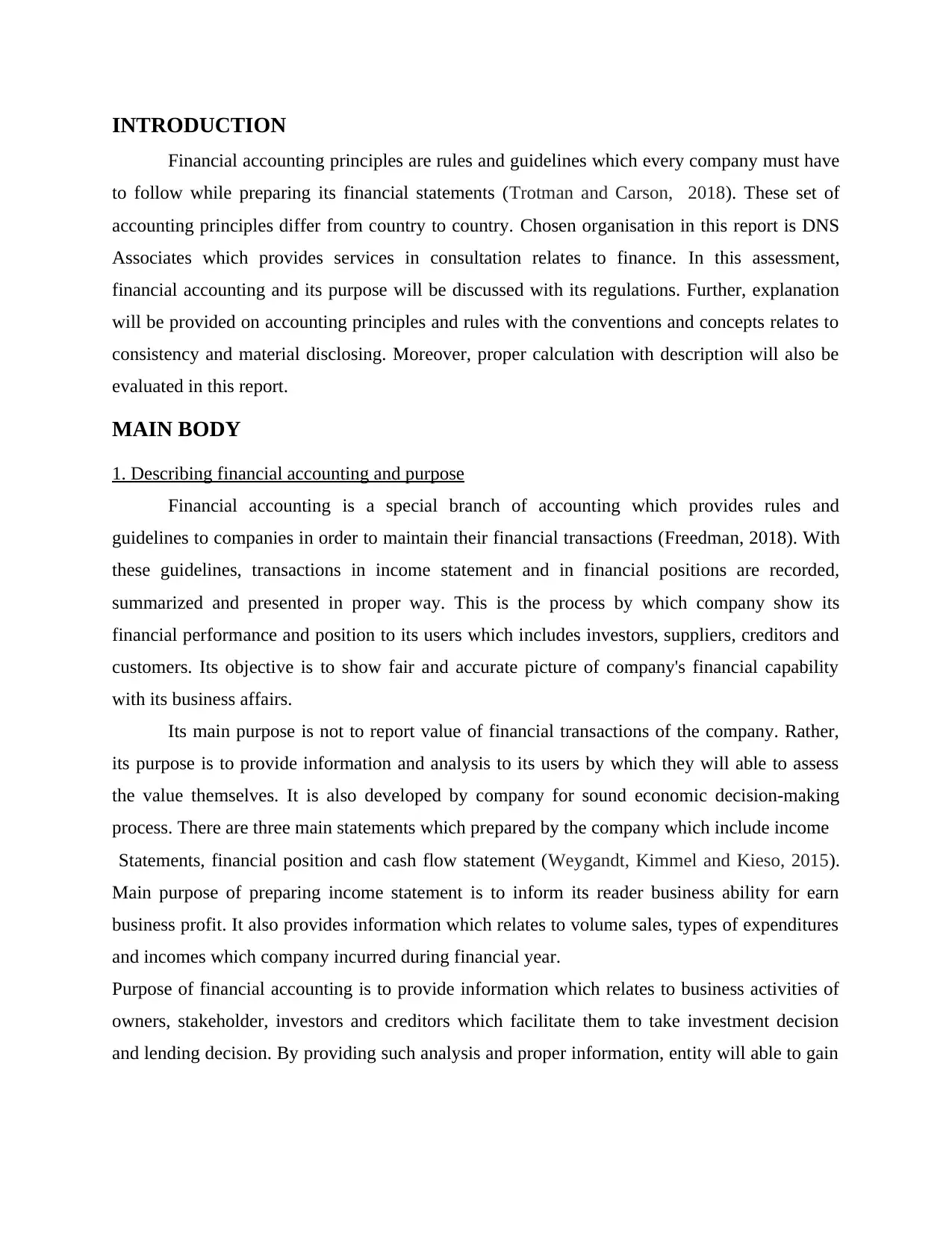
INTRODUCTION
Financial accounting principles are rules and guidelines which every company must have
to follow while preparing its financial statements (Trotman and Carson, 2018). These set of
accounting principles differ from country to country. Chosen organisation in this report is DNS
Associates which provides services in consultation relates to finance. In this assessment,
financial accounting and its purpose will be discussed with its regulations. Further, explanation
will be provided on accounting principles and rules with the conventions and concepts relates to
consistency and material disclosing. Moreover, proper calculation with description will also be
evaluated in this report.
MAIN BODY
1. Describing financial accounting and purpose
Financial accounting is a special branch of accounting which provides rules and
guidelines to companies in order to maintain their financial transactions (Freedman, 2018). With
these guidelines, transactions in income statement and in financial positions are recorded,
summarized and presented in proper way. This is the process by which company show its
financial performance and position to its users which includes investors, suppliers, creditors and
customers. Its objective is to show fair and accurate picture of company's financial capability
with its business affairs.
Its main purpose is not to report value of financial transactions of the company. Rather,
its purpose is to provide information and analysis to its users by which they will able to assess
the value themselves. It is also developed by company for sound economic decision-making
process. There are three main statements which prepared by the company which include income
Statements, financial position and cash flow statement (Weygandt, Kimmel and Kieso, 2015).
Main purpose of preparing income statement is to inform its reader business ability for earn
business profit. It also provides information which relates to volume sales, types of expenditures
and incomes which company incurred during financial year.
Purpose of financial accounting is to provide information which relates to business activities of
owners, stakeholder, investors and creditors which facilitate them to take investment decision
and lending decision. By providing such analysis and proper information, entity will able to gain
Financial accounting principles are rules and guidelines which every company must have
to follow while preparing its financial statements (Trotman and Carson, 2018). These set of
accounting principles differ from country to country. Chosen organisation in this report is DNS
Associates which provides services in consultation relates to finance. In this assessment,
financial accounting and its purpose will be discussed with its regulations. Further, explanation
will be provided on accounting principles and rules with the conventions and concepts relates to
consistency and material disclosing. Moreover, proper calculation with description will also be
evaluated in this report.
MAIN BODY
1. Describing financial accounting and purpose
Financial accounting is a special branch of accounting which provides rules and
guidelines to companies in order to maintain their financial transactions (Freedman, 2018). With
these guidelines, transactions in income statement and in financial positions are recorded,
summarized and presented in proper way. This is the process by which company show its
financial performance and position to its users which includes investors, suppliers, creditors and
customers. Its objective is to show fair and accurate picture of company's financial capability
with its business affairs.
Its main purpose is not to report value of financial transactions of the company. Rather,
its purpose is to provide information and analysis to its users by which they will able to assess
the value themselves. It is also developed by company for sound economic decision-making
process. There are three main statements which prepared by the company which include income
Statements, financial position and cash flow statement (Weygandt, Kimmel and Kieso, 2015).
Main purpose of preparing income statement is to inform its reader business ability for earn
business profit. It also provides information which relates to volume sales, types of expenditures
and incomes which company incurred during financial year.
Purpose of financial accounting is to provide information which relates to business activities of
owners, stakeholder, investors and creditors which facilitate them to take investment decision
and lending decision. By providing such analysis and proper information, entity will able to gain
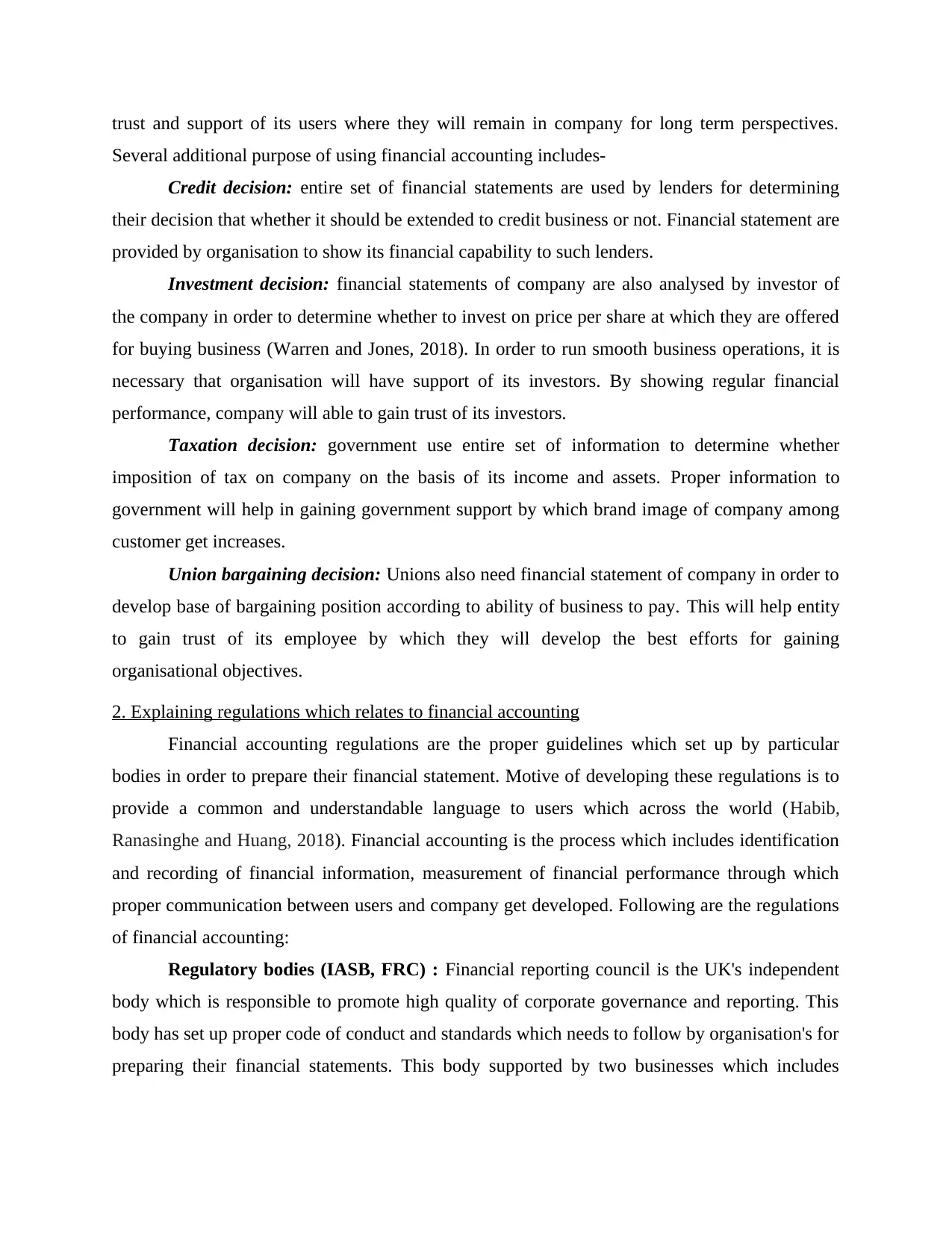
trust and support of its users where they will remain in company for long term perspectives.
Several additional purpose of using financial accounting includes-
Credit decision: entire set of financial statements are used by lenders for determining
their decision that whether it should be extended to credit business or not. Financial statement are
provided by organisation to show its financial capability to such lenders.
Investment decision: financial statements of company are also analysed by investor of
the company in order to determine whether to invest on price per share at which they are offered
for buying business (Warren and Jones, 2018). In order to run smooth business operations, it is
necessary that organisation will have support of its investors. By showing regular financial
performance, company will able to gain trust of its investors.
Taxation decision: government use entire set of information to determine whether
imposition of tax on company on the basis of its income and assets. Proper information to
government will help in gaining government support by which brand image of company among
customer get increases.
Union bargaining decision: Unions also need financial statement of company in order to
develop base of bargaining position according to ability of business to pay. This will help entity
to gain trust of its employee by which they will develop the best efforts for gaining
organisational objectives.
2. Explaining regulations which relates to financial accounting
Financial accounting regulations are the proper guidelines which set up by particular
bodies in order to prepare their financial statement. Motive of developing these regulations is to
provide a common and understandable language to users which across the world (Habib,
Ranasinghe and Huang, 2018). Financial accounting is the process which includes identification
and recording of financial information, measurement of financial performance through which
proper communication between users and company get developed. Following are the regulations
of financial accounting:
Regulatory bodies (IASB, FRC) : Financial reporting council is the UK's independent
body which is responsible to promote high quality of corporate governance and reporting. This
body has set up proper code of conduct and standards which needs to follow by organisation's for
preparing their financial statements. This body supported by two businesses which includes
Several additional purpose of using financial accounting includes-
Credit decision: entire set of financial statements are used by lenders for determining
their decision that whether it should be extended to credit business or not. Financial statement are
provided by organisation to show its financial capability to such lenders.
Investment decision: financial statements of company are also analysed by investor of
the company in order to determine whether to invest on price per share at which they are offered
for buying business (Warren and Jones, 2018). In order to run smooth business operations, it is
necessary that organisation will have support of its investors. By showing regular financial
performance, company will able to gain trust of its investors.
Taxation decision: government use entire set of information to determine whether
imposition of tax on company on the basis of its income and assets. Proper information to
government will help in gaining government support by which brand image of company among
customer get increases.
Union bargaining decision: Unions also need financial statement of company in order to
develop base of bargaining position according to ability of business to pay. This will help entity
to gain trust of its employee by which they will develop the best efforts for gaining
organisational objectives.
2. Explaining regulations which relates to financial accounting
Financial accounting regulations are the proper guidelines which set up by particular
bodies in order to prepare their financial statement. Motive of developing these regulations is to
provide a common and understandable language to users which across the world (Habib,
Ranasinghe and Huang, 2018). Financial accounting is the process which includes identification
and recording of financial information, measurement of financial performance through which
proper communication between users and company get developed. Following are the regulations
of financial accounting:
Regulatory bodies (IASB, FRC) : Financial reporting council is the UK's independent
body which is responsible to promote high quality of corporate governance and reporting. This
body has set up proper code of conduct and standards which needs to follow by organisation's for
preparing their financial statements. This body supported by two businesses which includes
Secure Best Marks with AI Grader
Need help grading? Try our AI Grader for instant feedback on your assignments.
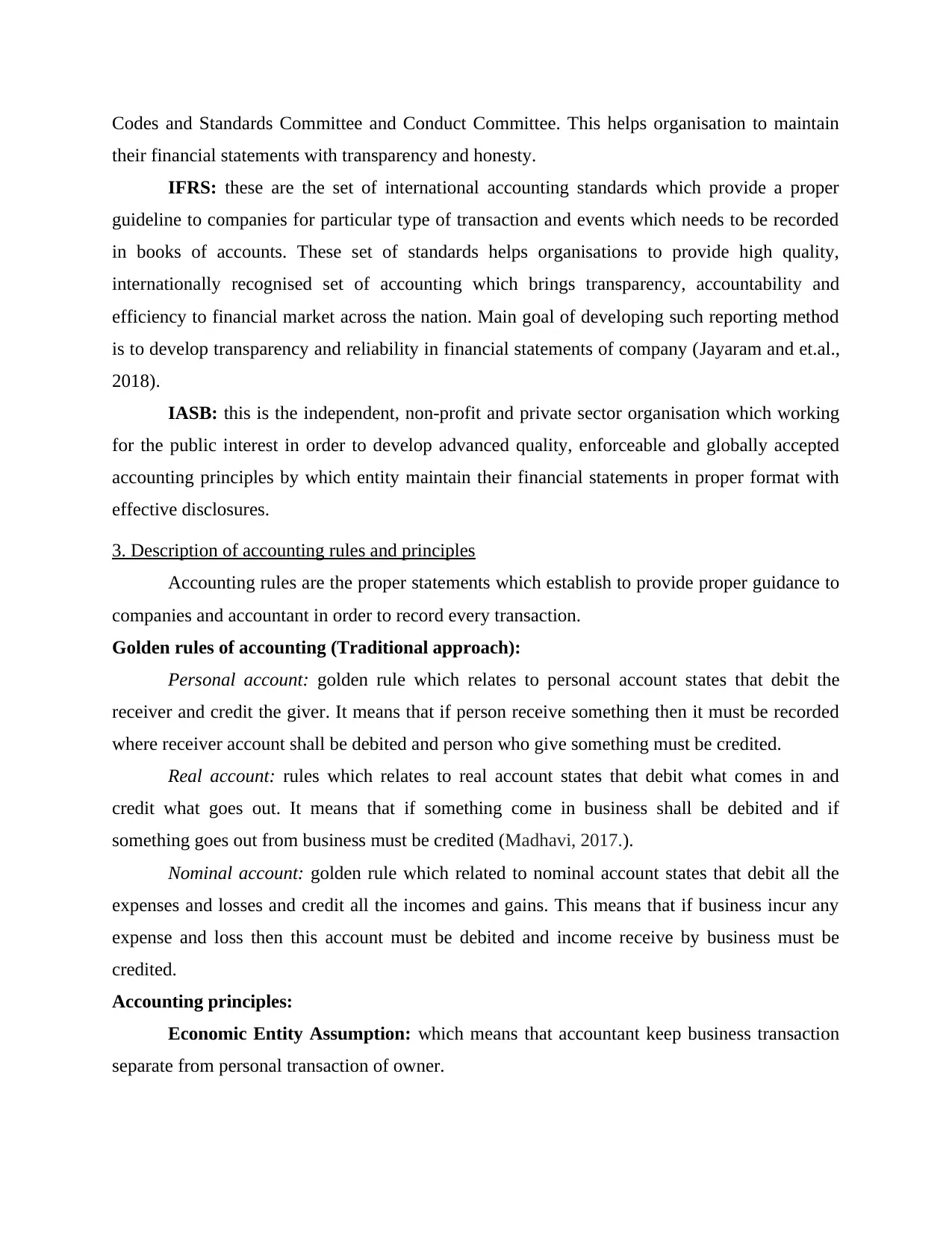
Codes and Standards Committee and Conduct Committee. This helps organisation to maintain
their financial statements with transparency and honesty.
IFRS: these are the set of international accounting standards which provide a proper
guideline to companies for particular type of transaction and events which needs to be recorded
in books of accounts. These set of standards helps organisations to provide high quality,
internationally recognised set of accounting which brings transparency, accountability and
efficiency to financial market across the nation. Main goal of developing such reporting method
is to develop transparency and reliability in financial statements of company (Jayaram and et.al.,
2018).
IASB: this is the independent, non-profit and private sector organisation which working
for the public interest in order to develop advanced quality, enforceable and globally accepted
accounting principles by which entity maintain their financial statements in proper format with
effective disclosures.
3. Description of accounting rules and principles
Accounting rules are the proper statements which establish to provide proper guidance to
companies and accountant in order to record every transaction.
Golden rules of accounting (Traditional approach):
Personal account: golden rule which relates to personal account states that debit the
receiver and credit the giver. It means that if person receive something then it must be recorded
where receiver account shall be debited and person who give something must be credited.
Real account: rules which relates to real account states that debit what comes in and
credit what goes out. It means that if something come in business shall be debited and if
something goes out from business must be credited (Madhavi, 2017.).
Nominal account: golden rule which related to nominal account states that debit all the
expenses and losses and credit all the incomes and gains. This means that if business incur any
expense and loss then this account must be debited and income receive by business must be
credited.
Accounting principles:
Economic Entity Assumption: which means that accountant keep business transaction
separate from personal transaction of owner.
their financial statements with transparency and honesty.
IFRS: these are the set of international accounting standards which provide a proper
guideline to companies for particular type of transaction and events which needs to be recorded
in books of accounts. These set of standards helps organisations to provide high quality,
internationally recognised set of accounting which brings transparency, accountability and
efficiency to financial market across the nation. Main goal of developing such reporting method
is to develop transparency and reliability in financial statements of company (Jayaram and et.al.,
2018).
IASB: this is the independent, non-profit and private sector organisation which working
for the public interest in order to develop advanced quality, enforceable and globally accepted
accounting principles by which entity maintain their financial statements in proper format with
effective disclosures.
3. Description of accounting rules and principles
Accounting rules are the proper statements which establish to provide proper guidance to
companies and accountant in order to record every transaction.
Golden rules of accounting (Traditional approach):
Personal account: golden rule which relates to personal account states that debit the
receiver and credit the giver. It means that if person receive something then it must be recorded
where receiver account shall be debited and person who give something must be credited.
Real account: rules which relates to real account states that debit what comes in and
credit what goes out. It means that if something come in business shall be debited and if
something goes out from business must be credited (Madhavi, 2017.).
Nominal account: golden rule which related to nominal account states that debit all the
expenses and losses and credit all the incomes and gains. This means that if business incur any
expense and loss then this account must be debited and income receive by business must be
credited.
Accounting principles:
Economic Entity Assumption: which means that accountant keep business transaction
separate from personal transaction of owner.
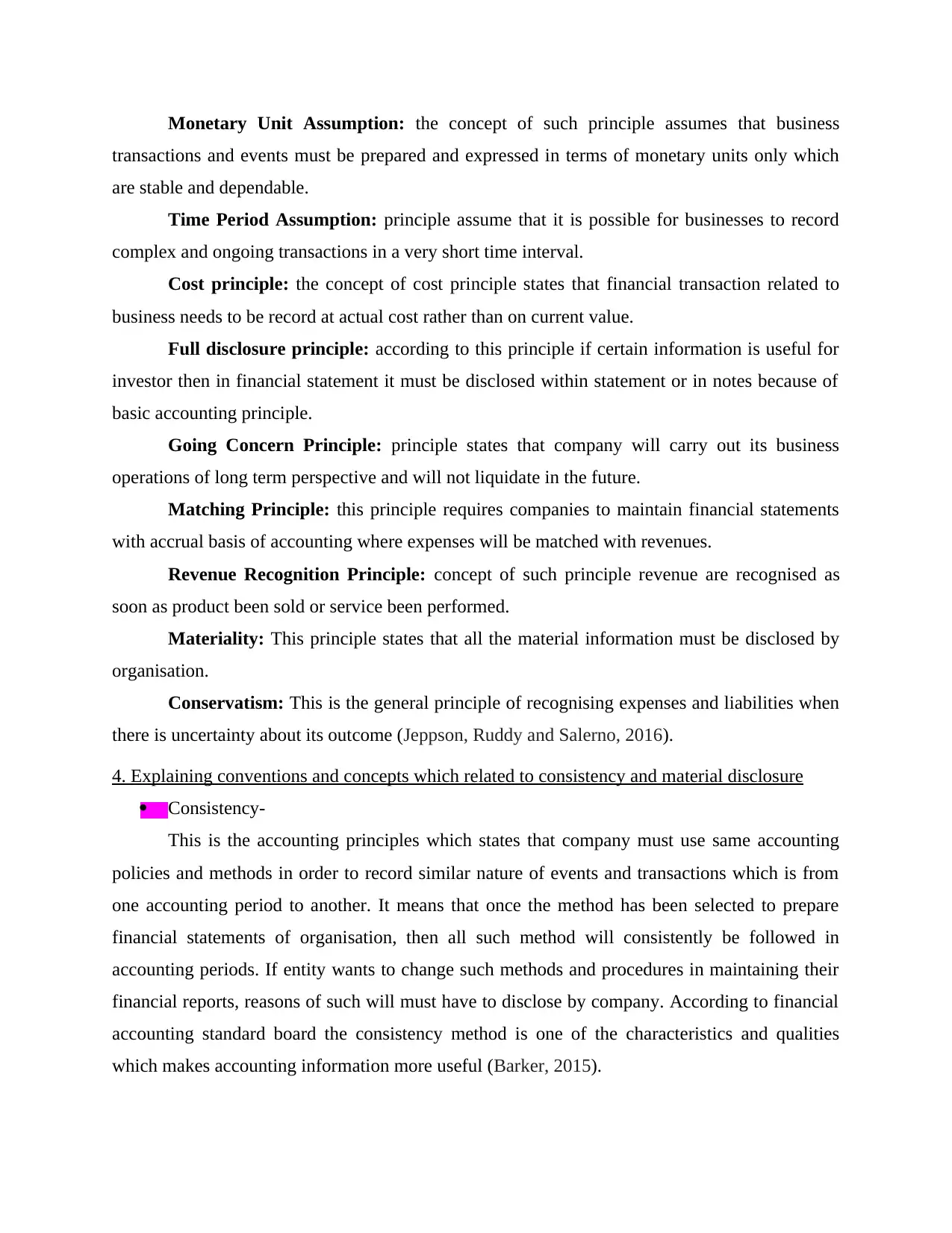
Monetary Unit Assumption: the concept of such principle assumes that business
transactions and events must be prepared and expressed in terms of monetary units only which
are stable and dependable.
Time Period Assumption: principle assume that it is possible for businesses to record
complex and ongoing transactions in a very short time interval.
Cost principle: the concept of cost principle states that financial transaction related to
business needs to be record at actual cost rather than on current value.
Full disclosure principle: according to this principle if certain information is useful for
investor then in financial statement it must be disclosed within statement or in notes because of
basic accounting principle.
Going Concern Principle: principle states that company will carry out its business
operations of long term perspective and will not liquidate in the future.
Matching Principle: this principle requires companies to maintain financial statements
with accrual basis of accounting where expenses will be matched with revenues.
Revenue Recognition Principle: concept of such principle revenue are recognised as
soon as product been sold or service been performed.
Materiality: This principle states that all the material information must be disclosed by
organisation.
Conservatism: This is the general principle of recognising expenses and liabilities when
there is uncertainty about its outcome (Jeppson, Ruddy and Salerno, 2016).
4. Explaining conventions and concepts which related to consistency and material disclosure
Consistency-
This is the accounting principles which states that company must use same accounting
policies and methods in order to record similar nature of events and transactions which is from
one accounting period to another. It means that once the method has been selected to prepare
financial statements of organisation, then all such method will consistently be followed in
accounting periods. If entity wants to change such methods and procedures in maintaining their
financial reports, reasons of such will must have to disclose by company. According to financial
accounting standard board the consistency method is one of the characteristics and qualities
which makes accounting information more useful (Barker, 2015).
transactions and events must be prepared and expressed in terms of monetary units only which
are stable and dependable.
Time Period Assumption: principle assume that it is possible for businesses to record
complex and ongoing transactions in a very short time interval.
Cost principle: the concept of cost principle states that financial transaction related to
business needs to be record at actual cost rather than on current value.
Full disclosure principle: according to this principle if certain information is useful for
investor then in financial statement it must be disclosed within statement or in notes because of
basic accounting principle.
Going Concern Principle: principle states that company will carry out its business
operations of long term perspective and will not liquidate in the future.
Matching Principle: this principle requires companies to maintain financial statements
with accrual basis of accounting where expenses will be matched with revenues.
Revenue Recognition Principle: concept of such principle revenue are recognised as
soon as product been sold or service been performed.
Materiality: This principle states that all the material information must be disclosed by
organisation.
Conservatism: This is the general principle of recognising expenses and liabilities when
there is uncertainty about its outcome (Jeppson, Ruddy and Salerno, 2016).
4. Explaining conventions and concepts which related to consistency and material disclosure
Consistency-
This is the accounting principles which states that company must use same accounting
policies and methods in order to record similar nature of events and transactions which is from
one accounting period to another. It means that once the method has been selected to prepare
financial statements of organisation, then all such method will consistently be followed in
accounting periods. If entity wants to change such methods and procedures in maintaining their
financial reports, reasons of such will must have to disclose by company. According to financial
accounting standard board the consistency method is one of the characteristics and qualities
which makes accounting information more useful (Barker, 2015).
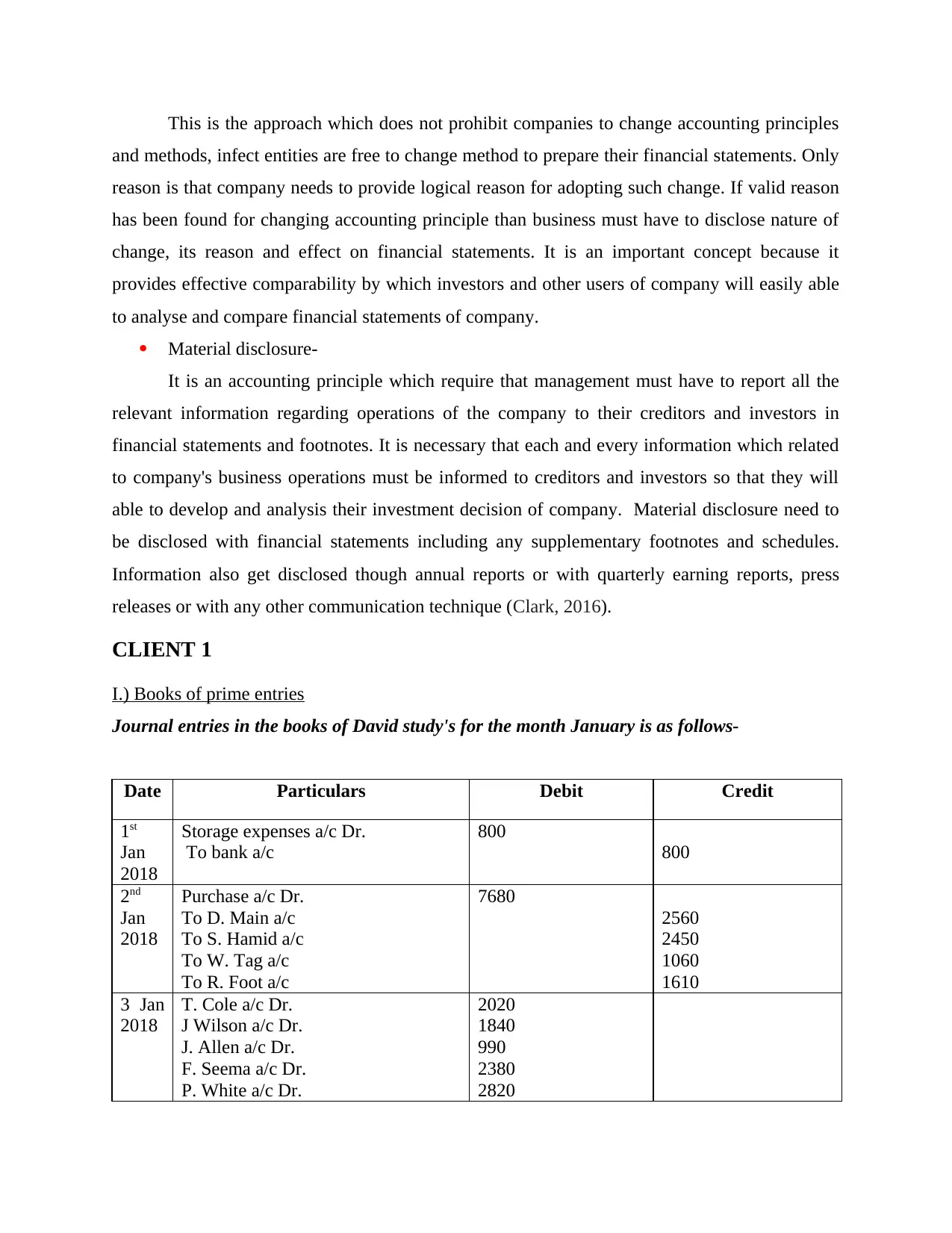
This is the approach which does not prohibit companies to change accounting principles
and methods, infect entities are free to change method to prepare their financial statements. Only
reason is that company needs to provide logical reason for adopting such change. If valid reason
has been found for changing accounting principle than business must have to disclose nature of
change, its reason and effect on financial statements. It is an important concept because it
provides effective comparability by which investors and other users of company will easily able
to analyse and compare financial statements of company.
Material disclosure-
It is an accounting principle which require that management must have to report all the
relevant information regarding operations of the company to their creditors and investors in
financial statements and footnotes. It is necessary that each and every information which related
to company's business operations must be informed to creditors and investors so that they will
able to develop and analysis their investment decision of company. Material disclosure need to
be disclosed with financial statements including any supplementary footnotes and schedules.
Information also get disclosed though annual reports or with quarterly earning reports, press
releases or with any other communication technique (Clark, 2016).
CLIENT 1
I.) Books of prime entries
Journal entries in the books of David study's for the month January is as follows-
Date Particulars Debit Credit
1st
Jan
2018
Storage expenses a/c Dr.
To bank a/c
800
800
2nd
Jan
2018
Purchase a/c Dr.
To D. Main a/c
To S. Hamid a/c
To W. Tag a/c
To R. Foot a/c
7680
2560
2450
1060
1610
3 Jan
2018
T. Cole a/c Dr.
J Wilson a/c Dr.
J. Allen a/c Dr.
F. Seema a/c Dr.
P. White a/c Dr.
2020
1840
990
2380
2820
and methods, infect entities are free to change method to prepare their financial statements. Only
reason is that company needs to provide logical reason for adopting such change. If valid reason
has been found for changing accounting principle than business must have to disclose nature of
change, its reason and effect on financial statements. It is an important concept because it
provides effective comparability by which investors and other users of company will easily able
to analyse and compare financial statements of company.
Material disclosure-
It is an accounting principle which require that management must have to report all the
relevant information regarding operations of the company to their creditors and investors in
financial statements and footnotes. It is necessary that each and every information which related
to company's business operations must be informed to creditors and investors so that they will
able to develop and analysis their investment decision of company. Material disclosure need to
be disclosed with financial statements including any supplementary footnotes and schedules.
Information also get disclosed though annual reports or with quarterly earning reports, press
releases or with any other communication technique (Clark, 2016).
CLIENT 1
I.) Books of prime entries
Journal entries in the books of David study's for the month January is as follows-
Date Particulars Debit Credit
1st
Jan
2018
Storage expenses a/c Dr.
To bank a/c
800
800
2nd
Jan
2018
Purchase a/c Dr.
To D. Main a/c
To S. Hamid a/c
To W. Tag a/c
To R. Foot a/c
7680
2560
2450
1060
1610
3 Jan
2018
T. Cole a/c Dr.
J Wilson a/c Dr.
J. Allen a/c Dr.
F. Seema a/c Dr.
P. White a/c Dr.
2020
1840
990
2380
2820
Paraphrase This Document
Need a fresh take? Get an instant paraphrase of this document with our AI Paraphraser
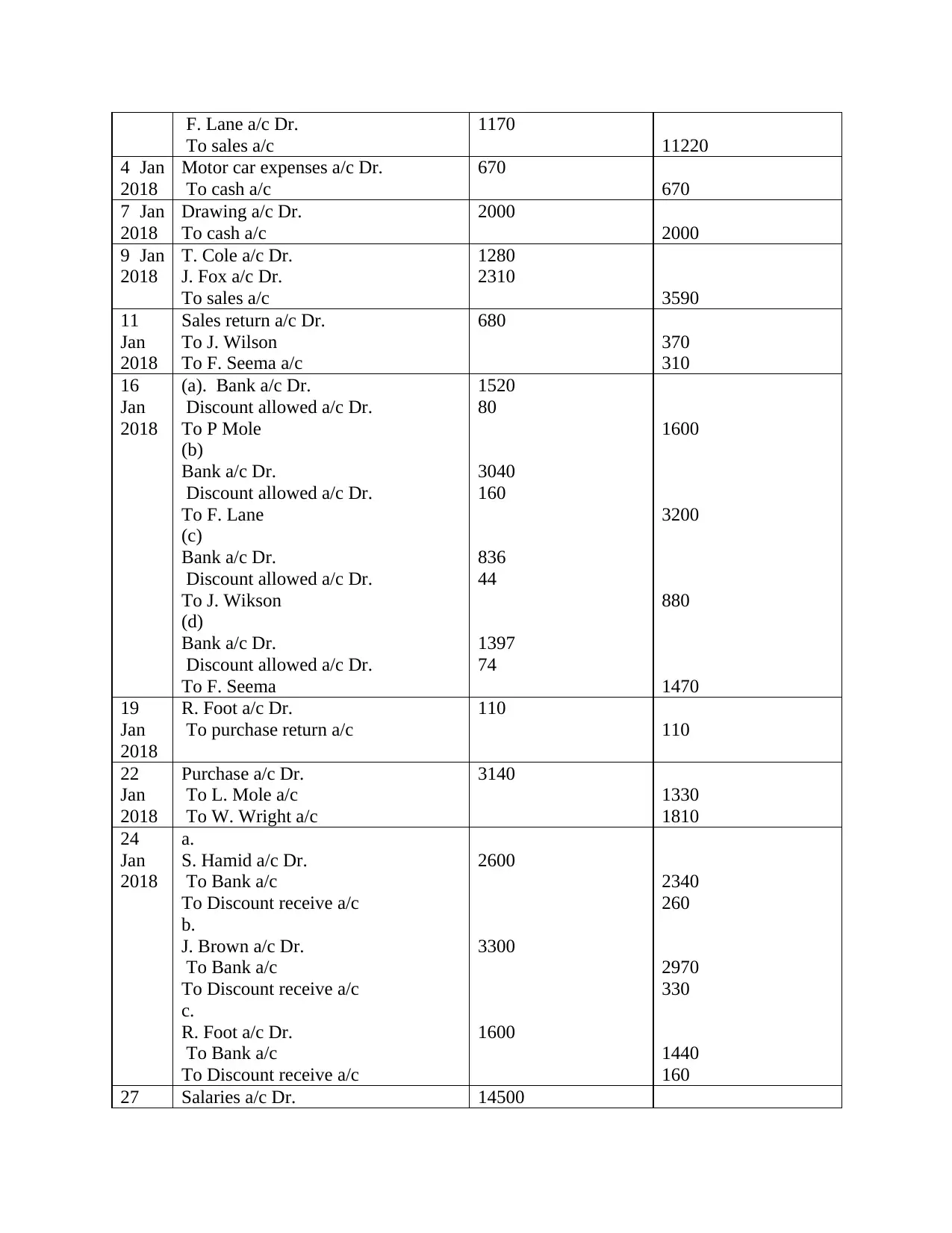
F. Lane a/c Dr.
To sales a/c
1170
11220
4 Jan
2018
Motor car expenses a/c Dr.
To cash a/c
670
670
7 Jan
2018
Drawing a/c Dr.
To cash a/c
2000
2000
9 Jan
2018
T. Cole a/c Dr.
J. Fox a/c Dr.
To sales a/c
1280
2310
3590
11
Jan
2018
Sales return a/c Dr.
To J. Wilson
To F. Seema a/c
680
370
310
16
Jan
2018
(a). Bank a/c Dr.
Discount allowed a/c Dr.
To P Mole
(b)
Bank a/c Dr.
Discount allowed a/c Dr.
To F. Lane
(c)
Bank a/c Dr.
Discount allowed a/c Dr.
To J. Wikson
(d)
Bank a/c Dr.
Discount allowed a/c Dr.
To F. Seema
1520
80
3040
160
836
44
1397
74
1600
3200
880
1470
19
Jan
2018
R. Foot a/c Dr.
To purchase return a/c
110
110
22
Jan
2018
Purchase a/c Dr.
To L. Mole a/c
To W. Wright a/c
3140
1330
1810
24
Jan
2018
a.
S. Hamid a/c Dr.
To Bank a/c
To Discount receive a/c
b.
J. Brown a/c Dr.
To Bank a/c
To Discount receive a/c
c.
R. Foot a/c Dr.
To Bank a/c
To Discount receive a/c
2600
3300
1600
2340
260
2970
330
1440
160
27 Salaries a/c Dr. 14500
To sales a/c
1170
11220
4 Jan
2018
Motor car expenses a/c Dr.
To cash a/c
670
670
7 Jan
2018
Drawing a/c Dr.
To cash a/c
2000
2000
9 Jan
2018
T. Cole a/c Dr.
J. Fox a/c Dr.
To sales a/c
1280
2310
3590
11
Jan
2018
Sales return a/c Dr.
To J. Wilson
To F. Seema a/c
680
370
310
16
Jan
2018
(a). Bank a/c Dr.
Discount allowed a/c Dr.
To P Mole
(b)
Bank a/c Dr.
Discount allowed a/c Dr.
To F. Lane
(c)
Bank a/c Dr.
Discount allowed a/c Dr.
To J. Wikson
(d)
Bank a/c Dr.
Discount allowed a/c Dr.
To F. Seema
1520
80
3040
160
836
44
1397
74
1600
3200
880
1470
19
Jan
2018
R. Foot a/c Dr.
To purchase return a/c
110
110
22
Jan
2018
Purchase a/c Dr.
To L. Mole a/c
To W. Wright a/c
3140
1330
1810
24
Jan
2018
a.
S. Hamid a/c Dr.
To Bank a/c
To Discount receive a/c
b.
J. Brown a/c Dr.
To Bank a/c
To Discount receive a/c
c.
R. Foot a/c Dr.
To Bank a/c
To Discount receive a/c
2600
3300
1600
2340
260
2970
330
1440
160
27 Salaries a/c Dr. 14500
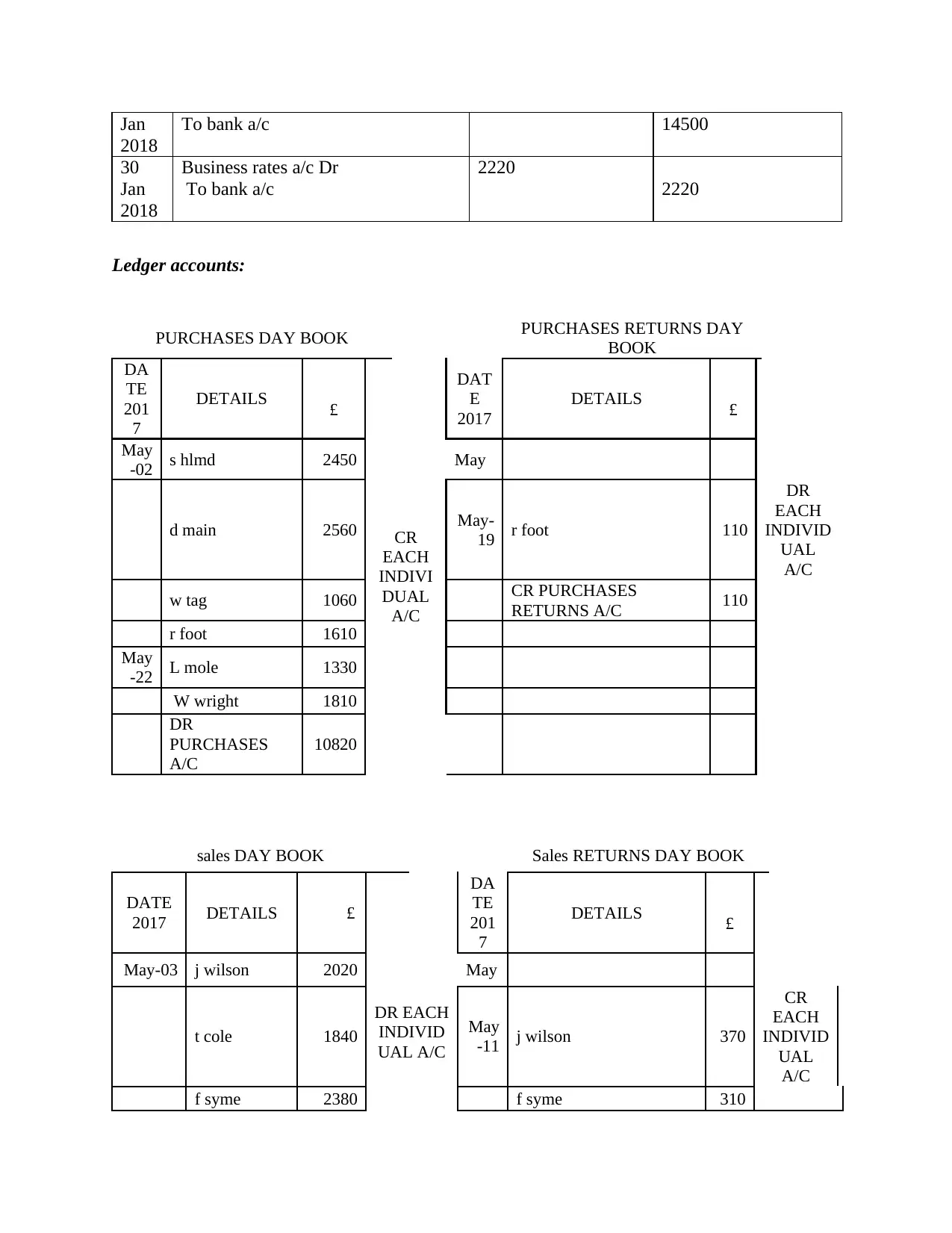
Jan
2018
To bank a/c 14500
30
Jan
2018
Business rates a/c Dr
To bank a/c
2220
2220
Ledger accounts:
PURCHASES DAY BOOK PURCHASES RETURNS DAY
BOOK
DA
TE
201
7
DETAILS £
DAT
E
2017
DETAILS £
May
-02 s hlmd 2450
CR
EACH
INDIVI
DUAL
A/C
May
d main 2560 May-
19 r foot 110
DR
EACH
INDIVID
UAL
A/C
w tag 1060 CR PURCHASES
RETURNS A/C 110
r foot 1610
May
-22 L mole 1330
W wright 1810
DR
PURCHASES
A/C
10820
sales DAY BOOK Sales RETURNS DAY BOOK
DATE
2017 DETAILS £
DA
TE
201
7
DETAILS £
May-03 j wilson 2020
DR EACH
INDIVID
UAL A/C
May
t cole 1840 May
-11 j wilson 370
CR
EACH
INDIVID
UAL
A/C
f syme 2380 f syme 310
2018
To bank a/c 14500
30
Jan
2018
Business rates a/c Dr
To bank a/c
2220
2220
Ledger accounts:
PURCHASES DAY BOOK PURCHASES RETURNS DAY
BOOK
DA
TE
201
7
DETAILS £
DAT
E
2017
DETAILS £
May
-02 s hlmd 2450
CR
EACH
INDIVI
DUAL
A/C
May
d main 2560 May-
19 r foot 110
DR
EACH
INDIVID
UAL
A/C
w tag 1060 CR PURCHASES
RETURNS A/C 110
r foot 1610
May
-22 L mole 1330
W wright 1810
DR
PURCHASES
A/C
10820
sales DAY BOOK Sales RETURNS DAY BOOK
DATE
2017 DETAILS £
DA
TE
201
7
DETAILS £
May-03 j wilson 2020
DR EACH
INDIVID
UAL A/C
May
t cole 1840 May
-11 j wilson 370
CR
EACH
INDIVID
UAL
A/C
f syme 2380 f syme 310
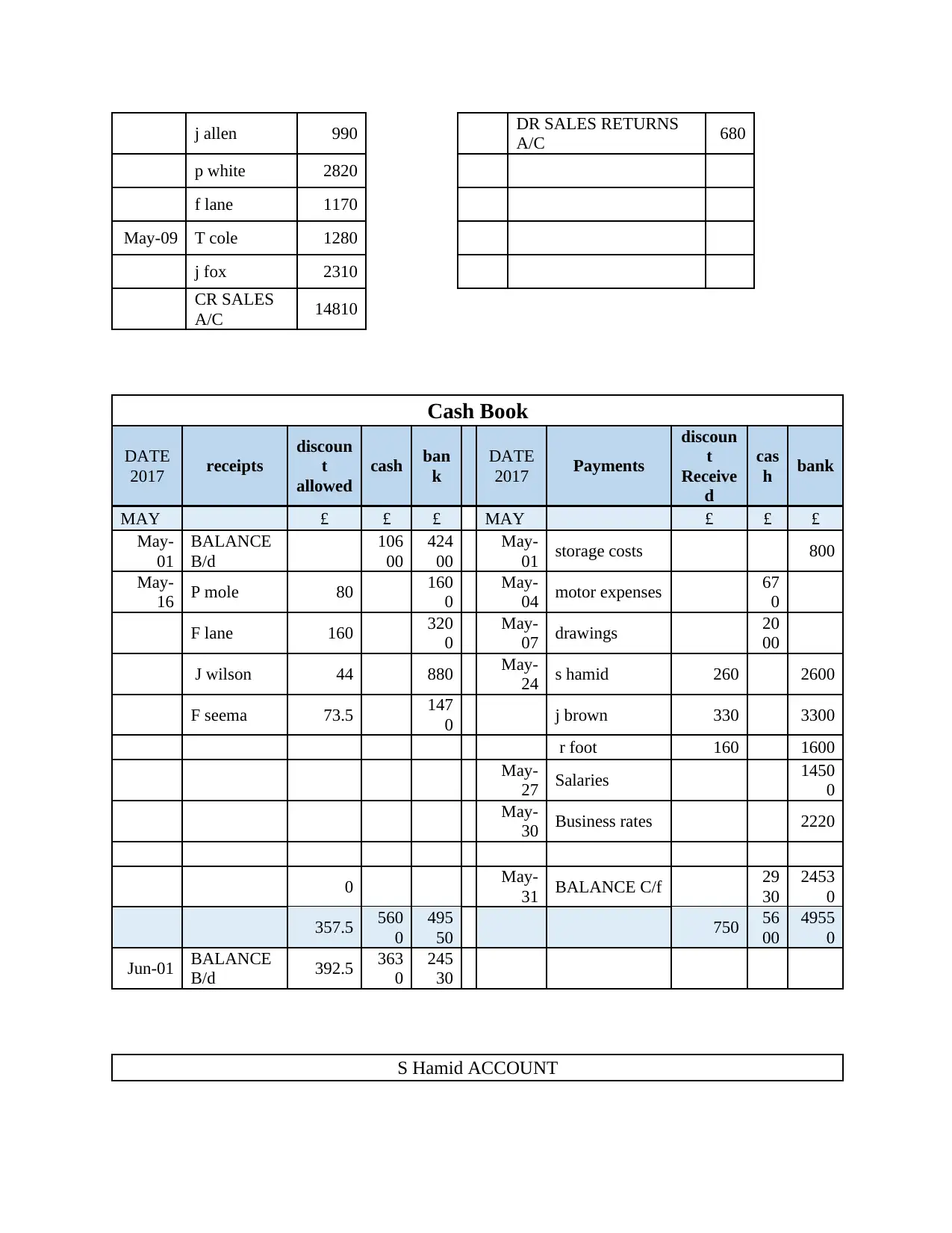
j allen 990 DR SALES RETURNS
A/C 680
p white 2820
f lane 1170
May-09 T cole 1280
j fox 2310
CR SALES
A/C 14810
Cash Book
DATE
2017 receipts
discoun
t
allowed
cash ban
k
DATE
2017 Payments
discoun
t
Receive
d
cas
h bank
MAY £ £ £ MAY £ £ £
May-
01
BALANCE
B/d
106
00
424
00
May-
01 storage costs 800
May-
16 P mole 80 160
0
May-
04 motor expenses 67
0
F lane 160 320
0
May-
07 drawings 20
00
J wilson 44 880 May-
24 s hamid 260 2600
F seema 73.5 147
0 j brown 330 3300
r foot 160 1600
May-
27 Salaries 1450
0
May-
30 Business rates 2220
0 May-
31 BALANCE C/f 29
30
2453
0
357.5 560
0
495
50 750 56
00
4955
0
Jun-01 BALANCE
B/d 392.5 363
0
245
30
S Hamid ACCOUNT
A/C 680
p white 2820
f lane 1170
May-09 T cole 1280
j fox 2310
CR SALES
A/C 14810
Cash Book
DATE
2017 receipts
discoun
t
allowed
cash ban
k
DATE
2017 Payments
discoun
t
Receive
d
cas
h bank
MAY £ £ £ MAY £ £ £
May-
01
BALANCE
B/d
106
00
424
00
May-
01 storage costs 800
May-
16 P mole 80 160
0
May-
04 motor expenses 67
0
F lane 160 320
0
May-
07 drawings 20
00
J wilson 44 880 May-
24 s hamid 260 2600
F seema 73.5 147
0 j brown 330 3300
r foot 160 1600
May-
27 Salaries 1450
0
May-
30 Business rates 2220
0 May-
31 BALANCE C/f 29
30
2453
0
357.5 560
0
495
50 750 56
00
4955
0
Jun-01 BALANCE
B/d 392.5 363
0
245
30
S Hamid ACCOUNT
Secure Best Marks with AI Grader
Need help grading? Try our AI Grader for instant feedback on your assignments.
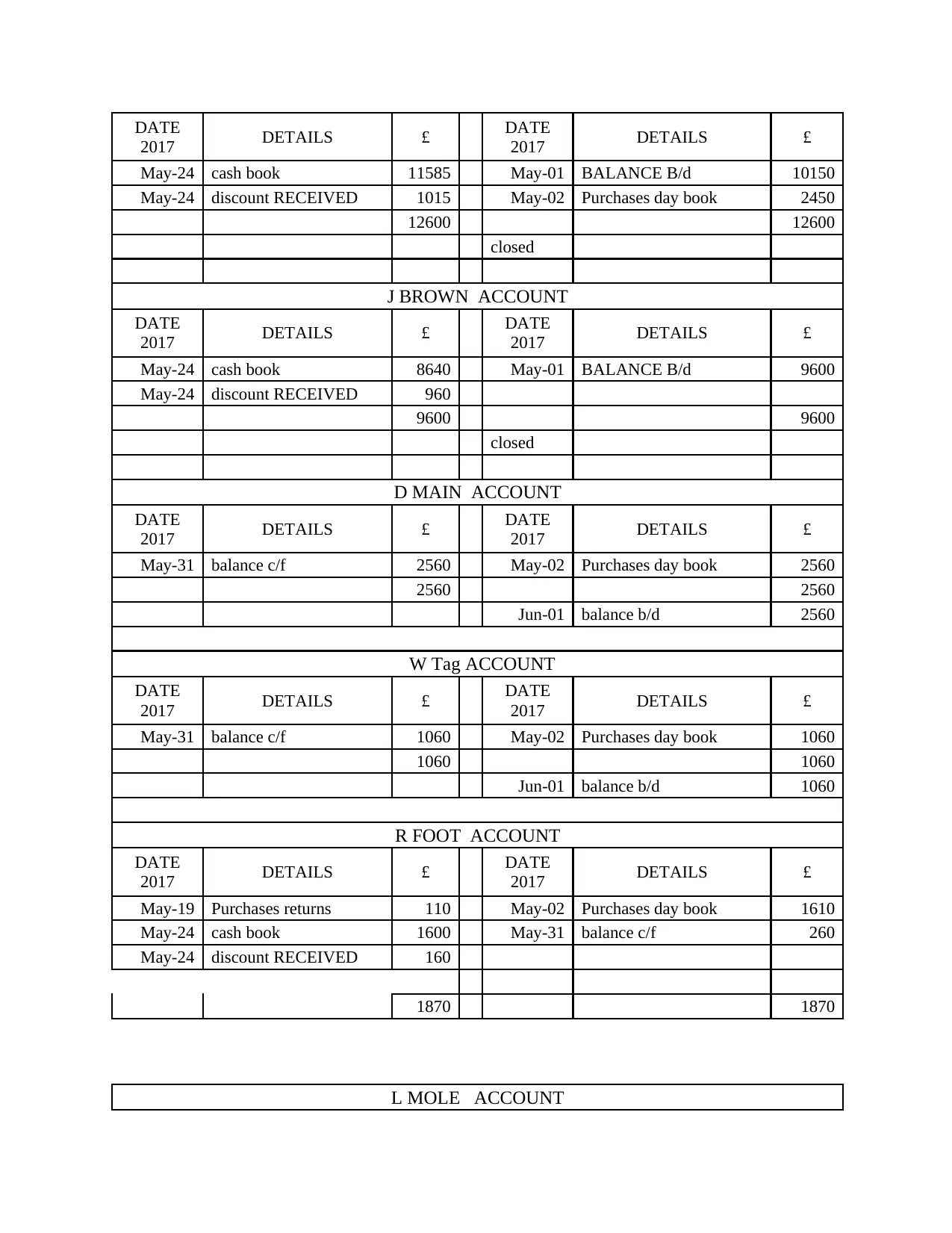
DATE
2017 DETAILS £ DATE
2017 DETAILS £
May-24 cash book 11585 May-01 BALANCE B/d 10150
May-24 discount RECEIVED 1015 May-02 Purchases day book 2450
12600 12600
closed
J BROWN ACCOUNT
DATE
2017 DETAILS £ DATE
2017 DETAILS £
May-24 cash book 8640 May-01 BALANCE B/d 9600
May-24 discount RECEIVED 960
9600 9600
closed
D MAIN ACCOUNT
DATE
2017 DETAILS £ DATE
2017 DETAILS £
May-31 balance c/f 2560 May-02 Purchases day book 2560
2560 2560
Jun-01 balance b/d 2560
W Tag ACCOUNT
DATE
2017 DETAILS £ DATE
2017 DETAILS £
May-31 balance c/f 1060 May-02 Purchases day book 1060
1060 1060
Jun-01 balance b/d 1060
R FOOT ACCOUNT
DATE
2017 DETAILS £ DATE
2017 DETAILS £
May-19 Purchases returns 110 May-02 Purchases day book 1610
May-24 cash book 1600 May-31 balance c/f 260
May-24 discount RECEIVED 160
1870 1870
L MOLE ACCOUNT
2017 DETAILS £ DATE
2017 DETAILS £
May-24 cash book 11585 May-01 BALANCE B/d 10150
May-24 discount RECEIVED 1015 May-02 Purchases day book 2450
12600 12600
closed
J BROWN ACCOUNT
DATE
2017 DETAILS £ DATE
2017 DETAILS £
May-24 cash book 8640 May-01 BALANCE B/d 9600
May-24 discount RECEIVED 960
9600 9600
closed
D MAIN ACCOUNT
DATE
2017 DETAILS £ DATE
2017 DETAILS £
May-31 balance c/f 2560 May-02 Purchases day book 2560
2560 2560
Jun-01 balance b/d 2560
W Tag ACCOUNT
DATE
2017 DETAILS £ DATE
2017 DETAILS £
May-31 balance c/f 1060 May-02 Purchases day book 1060
1060 1060
Jun-01 balance b/d 1060
R FOOT ACCOUNT
DATE
2017 DETAILS £ DATE
2017 DETAILS £
May-19 Purchases returns 110 May-02 Purchases day book 1610
May-24 cash book 1600 May-31 balance c/f 260
May-24 discount RECEIVED 160
1870 1870
L MOLE ACCOUNT
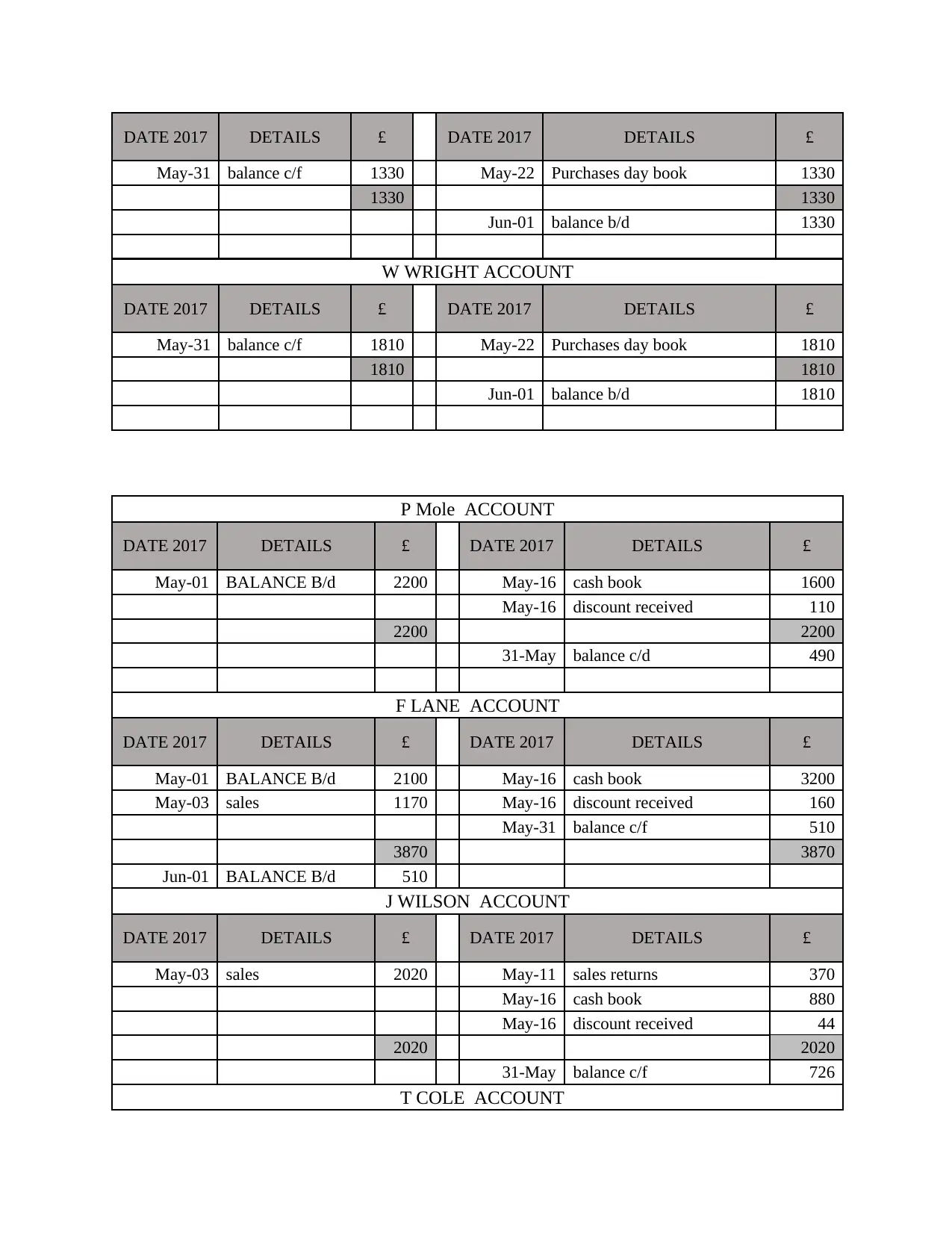
DATE 2017 DETAILS £ DATE 2017 DETAILS £
May-31 balance c/f 1330 May-22 Purchases day book 1330
1330 1330
Jun-01 balance b/d 1330
W WRIGHT ACCOUNT
DATE 2017 DETAILS £ DATE 2017 DETAILS £
May-31 balance c/f 1810 May-22 Purchases day book 1810
1810 1810
Jun-01 balance b/d 1810
P Mole ACCOUNT
DATE 2017 DETAILS £ DATE 2017 DETAILS £
May-01 BALANCE B/d 2200 May-16 cash book 1600
May-16 discount received 110
2200 2200
31-May balance c/d 490
F LANE ACCOUNT
DATE 2017 DETAILS £ DATE 2017 DETAILS £
May-01 BALANCE B/d 2100 May-16 cash book 3200
May-03 sales 1170 May-16 discount received 160
May-31 balance c/f 510
3870 3870
Jun-01 BALANCE B/d 510
J WILSON ACCOUNT
DATE 2017 DETAILS £ DATE 2017 DETAILS £
May-03 sales 2020 May-11 sales returns 370
May-16 cash book 880
May-16 discount received 44
2020 2020
31-May balance c/f 726
T COLE ACCOUNT
May-31 balance c/f 1330 May-22 Purchases day book 1330
1330 1330
Jun-01 balance b/d 1330
W WRIGHT ACCOUNT
DATE 2017 DETAILS £ DATE 2017 DETAILS £
May-31 balance c/f 1810 May-22 Purchases day book 1810
1810 1810
Jun-01 balance b/d 1810
P Mole ACCOUNT
DATE 2017 DETAILS £ DATE 2017 DETAILS £
May-01 BALANCE B/d 2200 May-16 cash book 1600
May-16 discount received 110
2200 2200
31-May balance c/d 490
F LANE ACCOUNT
DATE 2017 DETAILS £ DATE 2017 DETAILS £
May-01 BALANCE B/d 2100 May-16 cash book 3200
May-03 sales 1170 May-16 discount received 160
May-31 balance c/f 510
3870 3870
Jun-01 BALANCE B/d 510
J WILSON ACCOUNT
DATE 2017 DETAILS £ DATE 2017 DETAILS £
May-03 sales 2020 May-11 sales returns 370
May-16 cash book 880
May-16 discount received 44
2020 2020
31-May balance c/f 726
T COLE ACCOUNT
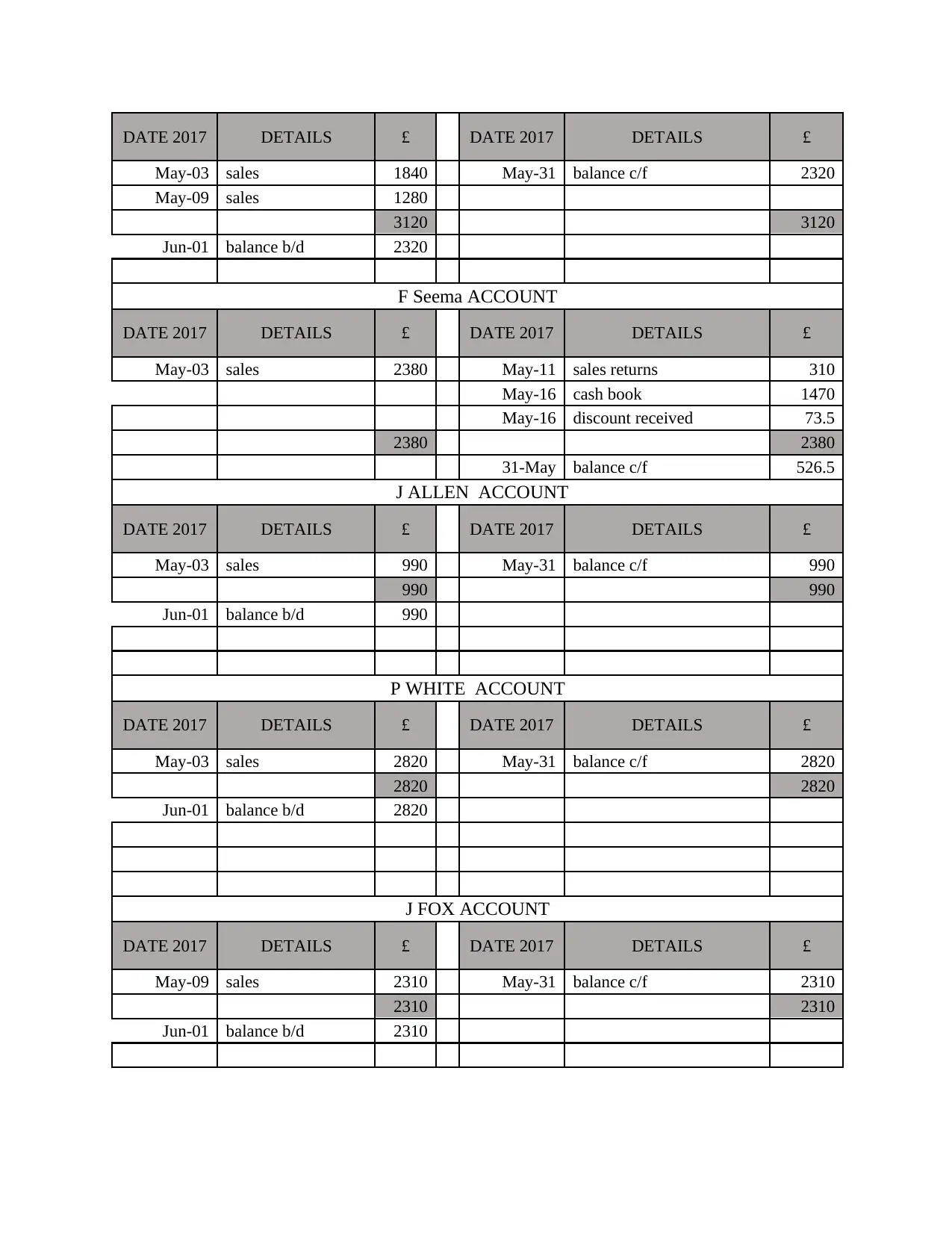
DATE 2017 DETAILS £ DATE 2017 DETAILS £
May-03 sales 1840 May-31 balance c/f 2320
May-09 sales 1280
3120 3120
Jun-01 balance b/d 2320
F Seema ACCOUNT
DATE 2017 DETAILS £ DATE 2017 DETAILS £
May-03 sales 2380 May-11 sales returns 310
May-16 cash book 1470
May-16 discount received 73.5
2380 2380
31-May balance c/f 526.5
J ALLEN ACCOUNT
DATE 2017 DETAILS £ DATE 2017 DETAILS £
May-03 sales 990 May-31 balance c/f 990
990 990
Jun-01 balance b/d 990
P WHITE ACCOUNT
DATE 2017 DETAILS £ DATE 2017 DETAILS £
May-03 sales 2820 May-31 balance c/f 2820
2820 2820
Jun-01 balance b/d 2820
J FOX ACCOUNT
DATE 2017 DETAILS £ DATE 2017 DETAILS £
May-09 sales 2310 May-31 balance c/f 2310
2310 2310
Jun-01 balance b/d 2310
May-03 sales 1840 May-31 balance c/f 2320
May-09 sales 1280
3120 3120
Jun-01 balance b/d 2320
F Seema ACCOUNT
DATE 2017 DETAILS £ DATE 2017 DETAILS £
May-03 sales 2380 May-11 sales returns 310
May-16 cash book 1470
May-16 discount received 73.5
2380 2380
31-May balance c/f 526.5
J ALLEN ACCOUNT
DATE 2017 DETAILS £ DATE 2017 DETAILS £
May-03 sales 990 May-31 balance c/f 990
990 990
Jun-01 balance b/d 990
P WHITE ACCOUNT
DATE 2017 DETAILS £ DATE 2017 DETAILS £
May-03 sales 2820 May-31 balance c/f 2820
2820 2820
Jun-01 balance b/d 2820
J FOX ACCOUNT
DATE 2017 DETAILS £ DATE 2017 DETAILS £
May-09 sales 2310 May-31 balance c/f 2310
2310 2310
Jun-01 balance b/d 2310
Paraphrase This Document
Need a fresh take? Get an instant paraphrase of this document with our AI Paraphraser
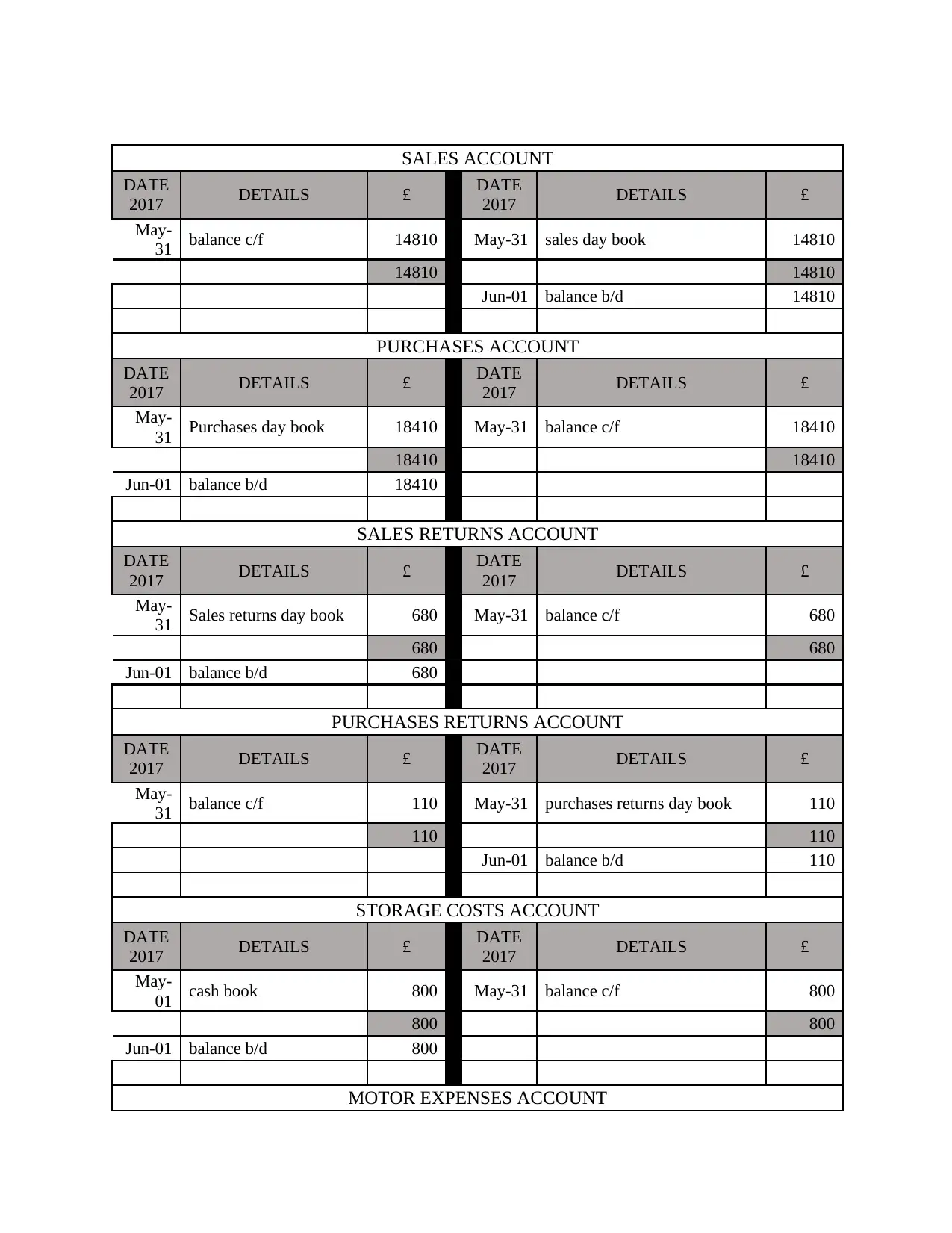
SALES ACCOUNT
DATE
2017 DETAILS £ DATE
2017 DETAILS £
May-
31 balance c/f 14810 May-31 sales day book 14810
14810 14810
Jun-01 balance b/d 14810
PURCHASES ACCOUNT
DATE
2017 DETAILS £ DATE
2017 DETAILS £
May-
31 Purchases day book 18410 May-31 balance c/f 18410
18410 18410
Jun-01 balance b/d 18410
SALES RETURNS ACCOUNT
DATE
2017 DETAILS £ DATE
2017 DETAILS £
May-
31 Sales returns day book 680 May-31 balance c/f 680
680 680
Jun-01 balance b/d 680
PURCHASES RETURNS ACCOUNT
DATE
2017 DETAILS £ DATE
2017 DETAILS £
May-
31 balance c/f 110 May-31 purchases returns day book 110
110 110
Jun-01 balance b/d 110
STORAGE COSTS ACCOUNT
DATE
2017 DETAILS £ DATE
2017 DETAILS £
May-
01 cash book 800 May-31 balance c/f 800
800 800
Jun-01 balance b/d 800
MOTOR EXPENSES ACCOUNT
DATE
2017 DETAILS £ DATE
2017 DETAILS £
May-
31 balance c/f 14810 May-31 sales day book 14810
14810 14810
Jun-01 balance b/d 14810
PURCHASES ACCOUNT
DATE
2017 DETAILS £ DATE
2017 DETAILS £
May-
31 Purchases day book 18410 May-31 balance c/f 18410
18410 18410
Jun-01 balance b/d 18410
SALES RETURNS ACCOUNT
DATE
2017 DETAILS £ DATE
2017 DETAILS £
May-
31 Sales returns day book 680 May-31 balance c/f 680
680 680
Jun-01 balance b/d 680
PURCHASES RETURNS ACCOUNT
DATE
2017 DETAILS £ DATE
2017 DETAILS £
May-
31 balance c/f 110 May-31 purchases returns day book 110
110 110
Jun-01 balance b/d 110
STORAGE COSTS ACCOUNT
DATE
2017 DETAILS £ DATE
2017 DETAILS £
May-
01 cash book 800 May-31 balance c/f 800
800 800
Jun-01 balance b/d 800
MOTOR EXPENSES ACCOUNT

DATE
2017 DETAILS £ DATE
2017 DETAILS £
May-
04 cash book 670 May-31 balance c/f 670
670 670
Jun-01 balance b/d 670
DRAWINGS ACCOUNT
DATE
2017 DETAILS £ DATE
2017 DETAILS £
May-
07 cash book 2000 May-31 balance c/f 2000
2000 2000
Jun-01 balance b/d 2000
DISCOUNT ALLOWED ACCOUNT
DATE
2017 DETAILS £ DATE
2017 DETAILS £
May-
31 cash book 387.5 May-31 balance c/f 387.5
387.5 387.5
Jun-01 balance b/d 387.5
DISCOUNT RECEIVED ACCOUNT
DATE
2017 DETAILS £ DATE
2017 DETAILS £
May-
31 balance c/f 2135 May-31 cash book 2135
2135 2135
Jun-01 balance b/d 2135
SALARIES ACCOUNT
DATE
2017 DETAILS £ DATE
2017 DETAILS £
May-
27 cash book 14500 May-31 balance c/f 14500
14500 14500
Jun-01 balance b/d 14500
BUSINESS RATES ACCOUNT
DATE
2017 DETAILS £ DATE
2017 DETAILS £
May-
30 cash book 2220 May-31 balance c/f 2220
2017 DETAILS £ DATE
2017 DETAILS £
May-
04 cash book 670 May-31 balance c/f 670
670 670
Jun-01 balance b/d 670
DRAWINGS ACCOUNT
DATE
2017 DETAILS £ DATE
2017 DETAILS £
May-
07 cash book 2000 May-31 balance c/f 2000
2000 2000
Jun-01 balance b/d 2000
DISCOUNT ALLOWED ACCOUNT
DATE
2017 DETAILS £ DATE
2017 DETAILS £
May-
31 cash book 387.5 May-31 balance c/f 387.5
387.5 387.5
Jun-01 balance b/d 387.5
DISCOUNT RECEIVED ACCOUNT
DATE
2017 DETAILS £ DATE
2017 DETAILS £
May-
31 balance c/f 2135 May-31 cash book 2135
2135 2135
Jun-01 balance b/d 2135
SALARIES ACCOUNT
DATE
2017 DETAILS £ DATE
2017 DETAILS £
May-
27 cash book 14500 May-31 balance c/f 14500
14500 14500
Jun-01 balance b/d 14500
BUSINESS RATES ACCOUNT
DATE
2017 DETAILS £ DATE
2017 DETAILS £
May-
30 cash book 2220 May-31 balance c/f 2220
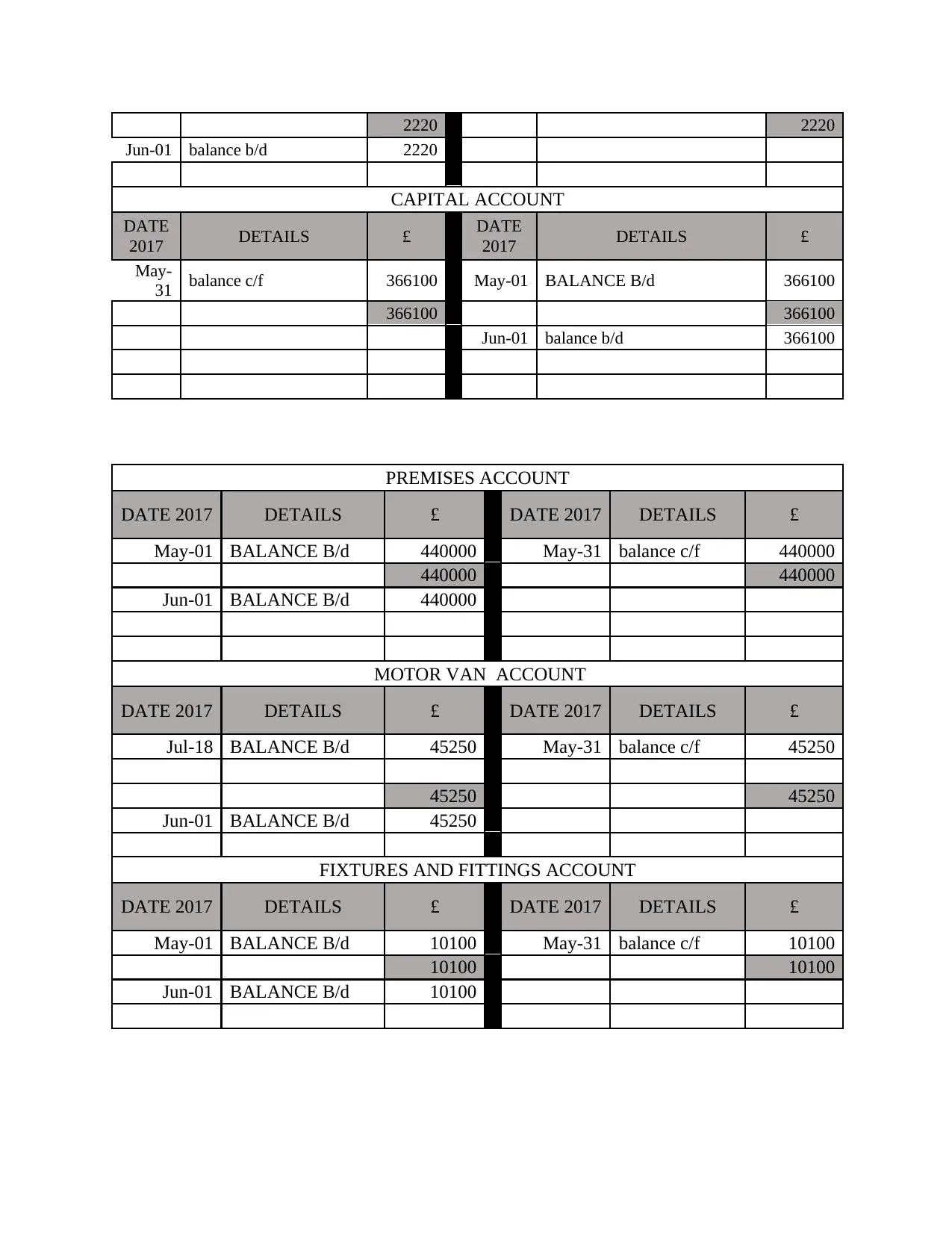
2220 2220
Jun-01 balance b/d 2220
CAPITAL ACCOUNT
DATE
2017 DETAILS £ DATE
2017 DETAILS £
May-
31 balance c/f 366100 May-01 BALANCE B/d 366100
366100 366100
Jun-01 balance b/d 366100
PREMISES ACCOUNT
DATE 2017 DETAILS £ DATE 2017 DETAILS £
May-01 BALANCE B/d 440000 May-31 balance c/f 440000
440000 440000
Jun-01 BALANCE B/d 440000
MOTOR VAN ACCOUNT
DATE 2017 DETAILS £ DATE 2017 DETAILS £
Jul-18 BALANCE B/d 45250 May-31 balance c/f 45250
45250 45250
Jun-01 BALANCE B/d 45250
FIXTURES AND FITTINGS ACCOUNT
DATE 2017 DETAILS £ DATE 2017 DETAILS £
May-01 BALANCE B/d 10100 May-31 balance c/f 10100
10100 10100
Jun-01 BALANCE B/d 10100
Jun-01 balance b/d 2220
CAPITAL ACCOUNT
DATE
2017 DETAILS £ DATE
2017 DETAILS £
May-
31 balance c/f 366100 May-01 BALANCE B/d 366100
366100 366100
Jun-01 balance b/d 366100
PREMISES ACCOUNT
DATE 2017 DETAILS £ DATE 2017 DETAILS £
May-01 BALANCE B/d 440000 May-31 balance c/f 440000
440000 440000
Jun-01 BALANCE B/d 440000
MOTOR VAN ACCOUNT
DATE 2017 DETAILS £ DATE 2017 DETAILS £
Jul-18 BALANCE B/d 45250 May-31 balance c/f 45250
45250 45250
Jun-01 BALANCE B/d 45250
FIXTURES AND FITTINGS ACCOUNT
DATE 2017 DETAILS £ DATE 2017 DETAILS £
May-01 BALANCE B/d 10100 May-31 balance c/f 10100
10100 10100
Jun-01 BALANCE B/d 10100
Secure Best Marks with AI Grader
Need help grading? Try our AI Grader for instant feedback on your assignments.
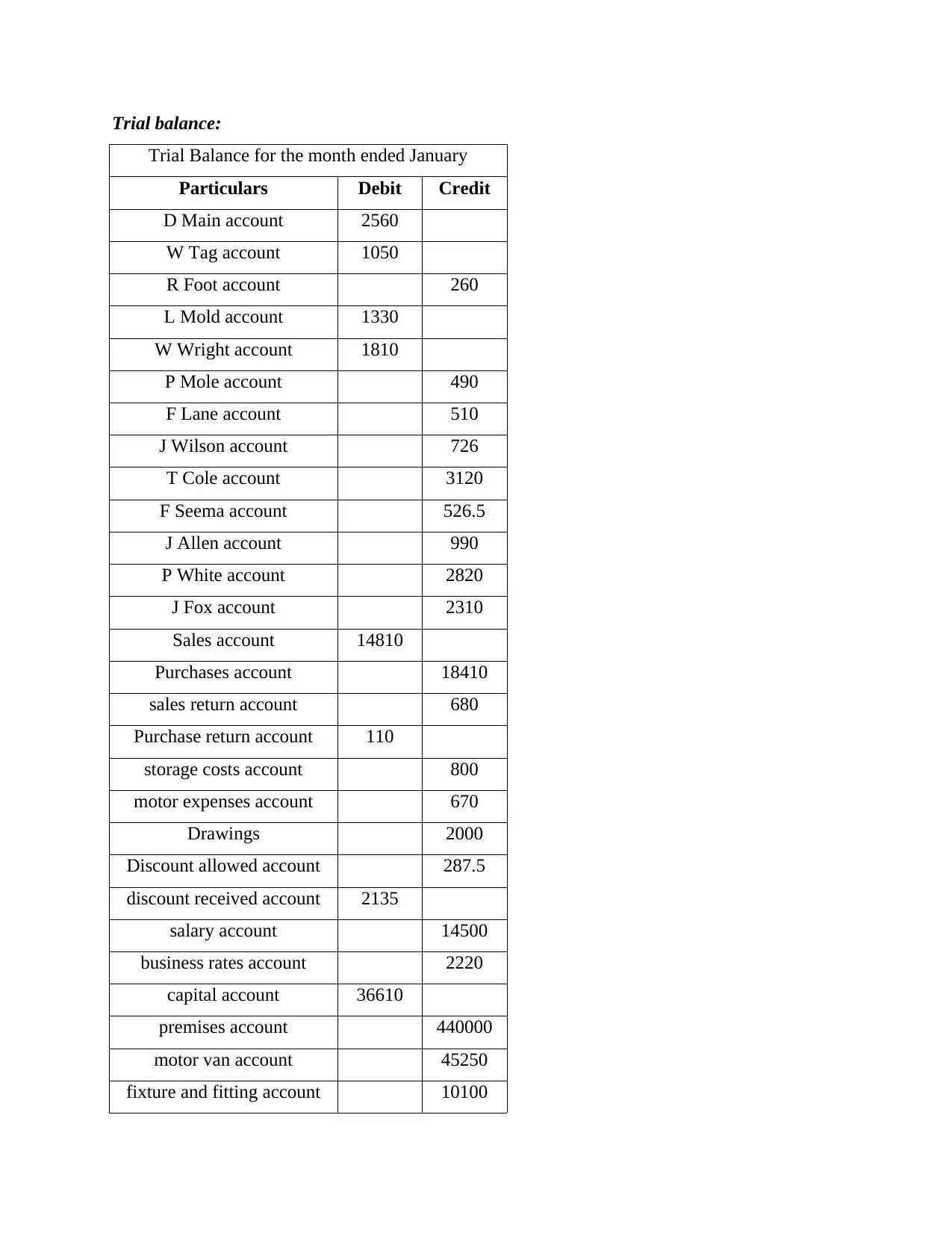
Trial balance:
Trial Balance for the month ended January
Particulars Debit Credit
D Main account 2560
W Tag account 1050
R Foot account 260
L Mold account 1330
W Wright account 1810
P Mole account 490
F Lane account 510
J Wilson account 726
T Cole account 3120
F Seema account 526.5
J Allen account 990
P White account 2820
J Fox account 2310
Sales account 14810
Purchases account 18410
sales return account 680
Purchase return account 110
storage costs account 800
motor expenses account 670
Drawings 2000
Discount allowed account 287.5
discount received account 2135
salary account 14500
business rates account 2220
capital account 36610
premises account 440000
motor van account 45250
fixture and fitting account 10100
Trial Balance for the month ended January
Particulars Debit Credit
D Main account 2560
W Tag account 1050
R Foot account 260
L Mold account 1330
W Wright account 1810
P Mole account 490
F Lane account 510
J Wilson account 726
T Cole account 3120
F Seema account 526.5
J Allen account 990
P White account 2820
J Fox account 2310
Sales account 14810
Purchases account 18410
sales return account 680
Purchase return account 110
storage costs account 800
motor expenses account 670
Drawings 2000
Discount allowed account 287.5
discount received account 2135
salary account 14500
business rates account 2220
capital account 36610
premises account 440000
motor van account 45250
fixture and fitting account 10100

cash in hand 5600
cash at bank 49550
suspense account 541395
Balance 546670 546670
CLIENT 2
Profit and loss account
Particulars £ £ £
Sales 1200000
less cost of sales
opening inventory 40500
add purchases 700000
740500
less closing inventory 42640 697860
Gross profit 502140
less Expenses
wages and salaries 165000
add amount accrued 1520 166520
motor expenses 45800
admin expenses 16500
heating and lightning 5500
advertising expenses 10300
less amount prepaid 4470 5830
depreciation on premises 5600
depreciation on equipment 19000
depreciation on motor vehicle 3600 28200 268350
Operating Profit 233790
cash at bank 49550
suspense account 541395
Balance 546670 546670
CLIENT 2
Profit and loss account
Particulars £ £ £
Sales 1200000
less cost of sales
opening inventory 40500
add purchases 700000
740500
less closing inventory 42640 697860
Gross profit 502140
less Expenses
wages and salaries 165000
add amount accrued 1520 166520
motor expenses 45800
admin expenses 16500
heating and lightning 5500
advertising expenses 10300
less amount prepaid 4470 5830
depreciation on premises 5600
depreciation on equipment 19000
depreciation on motor vehicle 3600 28200 268350
Operating Profit 233790

Balance sheet for the year ended 31 July 2018
Balance sheet Peter Doo for the year ended at 31st July, 2018
Particulars Amount (in £)
Current assets
Closing inventory 42640
Prepaid advertising 4470
Bills receivables
11520
0
cash in hand 3000
Total current assets 165310
Fixed assets
Freehold premises
28000
0
Less depreciation on premises: 5600
27440
0
Equipment
19000
0
Less: Depreciation on equipment 19000
17100
0
Motor Vehicles 30000
Less: Depreciation 3600 26400
Total fixed assets 471800
Total assets 637110
Liabilities
Balance sheet Peter Doo for the year ended at 31st July, 2018
Particulars Amount (in £)
Current assets
Closing inventory 42640
Prepaid advertising 4470
Bills receivables
11520
0
cash in hand 3000
Total current assets 165310
Fixed assets
Freehold premises
28000
0
Less depreciation on premises: 5600
27440
0
Equipment
19000
0
Less: Depreciation on equipment 19000
17100
0
Motor Vehicles 30000
Less: Depreciation 3600 26400
Total fixed assets 471800
Total assets 637110
Liabilities
Paraphrase This Document
Need a fresh take? Get an instant paraphrase of this document with our AI Paraphraser

Accumulated 40000
68000
12000 120000
Current liabilities
Bills payables or creditors 56000
Outstanding salaries 1520
Bank overdraft 10000
Total current liabilities 67520
Capital
24380
0
Add: NP
23379
0
Less: Drawing 28000
Total shareholder’s capital 449590
Total liabilities or obligations 637110
CLIENT 3
A.) Profit and Loss statement
Bowling Limited statement of profit or loss for the year ended 31st July 2018
Particulars
Amoun
t (in £)
Amoun
t (in £)
Amount
(in £)
Sales 107000
Less: Sales return 2000 105000
Inventory at the end of period 18000
Stock at the beginning of the year 17000
Purchases 32000
less: purchase return 0 32000
Cost of Goods sold (COGS) 31000
68000
12000 120000
Current liabilities
Bills payables or creditors 56000
Outstanding salaries 1520
Bank overdraft 10000
Total current liabilities 67520
Capital
24380
0
Add: NP
23379
0
Less: Drawing 28000
Total shareholder’s capital 449590
Total liabilities or obligations 637110
CLIENT 3
A.) Profit and Loss statement
Bowling Limited statement of profit or loss for the year ended 31st July 2018
Particulars
Amoun
t (in £)
Amoun
t (in £)
Amount
(in £)
Sales 107000
Less: Sales return 2000 105000
Inventory at the end of period 18000
Stock at the beginning of the year 17000
Purchases 32000
less: purchase return 0 32000
Cost of Goods sold (COGS) 31000

GP (Gross profit) 74000
Depreciation on building 10000
Depreciation on plant and machinery 10000
Administration expenses 28000
Expenses pertaining to distribution 22000
Less: Prepaid rent 3000
Add: Outstanding salaries 2000 21000
Corporation tax 4000
73000
NP (Net profit) 1000
b.) statement of financial position
statement of financial position of Bowling Limited as at 31st July 2018
ASSETS £ £
NON-CURRENT ASSETS
Land & buildings 60000
Less: accumulated depreciation 7000
Less: depreciation 10000 43000
Plant & machinery 65000
Less: accumulated depreciation 15000
Less: depreciation 10000 40000
Total fixed assets 83000
CURRENT ASSETS
Inventory 18000
Trade Receivables 24000
Prepayments 3000
Depreciation on building 10000
Depreciation on plant and machinery 10000
Administration expenses 28000
Expenses pertaining to distribution 22000
Less: Prepaid rent 3000
Add: Outstanding salaries 2000 21000
Corporation tax 4000
73000
NP (Net profit) 1000
b.) statement of financial position
statement of financial position of Bowling Limited as at 31st July 2018
ASSETS £ £
NON-CURRENT ASSETS
Land & buildings 60000
Less: accumulated depreciation 7000
Less: depreciation 10000 43000
Plant & machinery 65000
Less: accumulated depreciation 15000
Less: depreciation 10000 40000
Total fixed assets 83000
CURRENT ASSETS
Inventory 18000
Trade Receivables 24000
Prepayments 3000
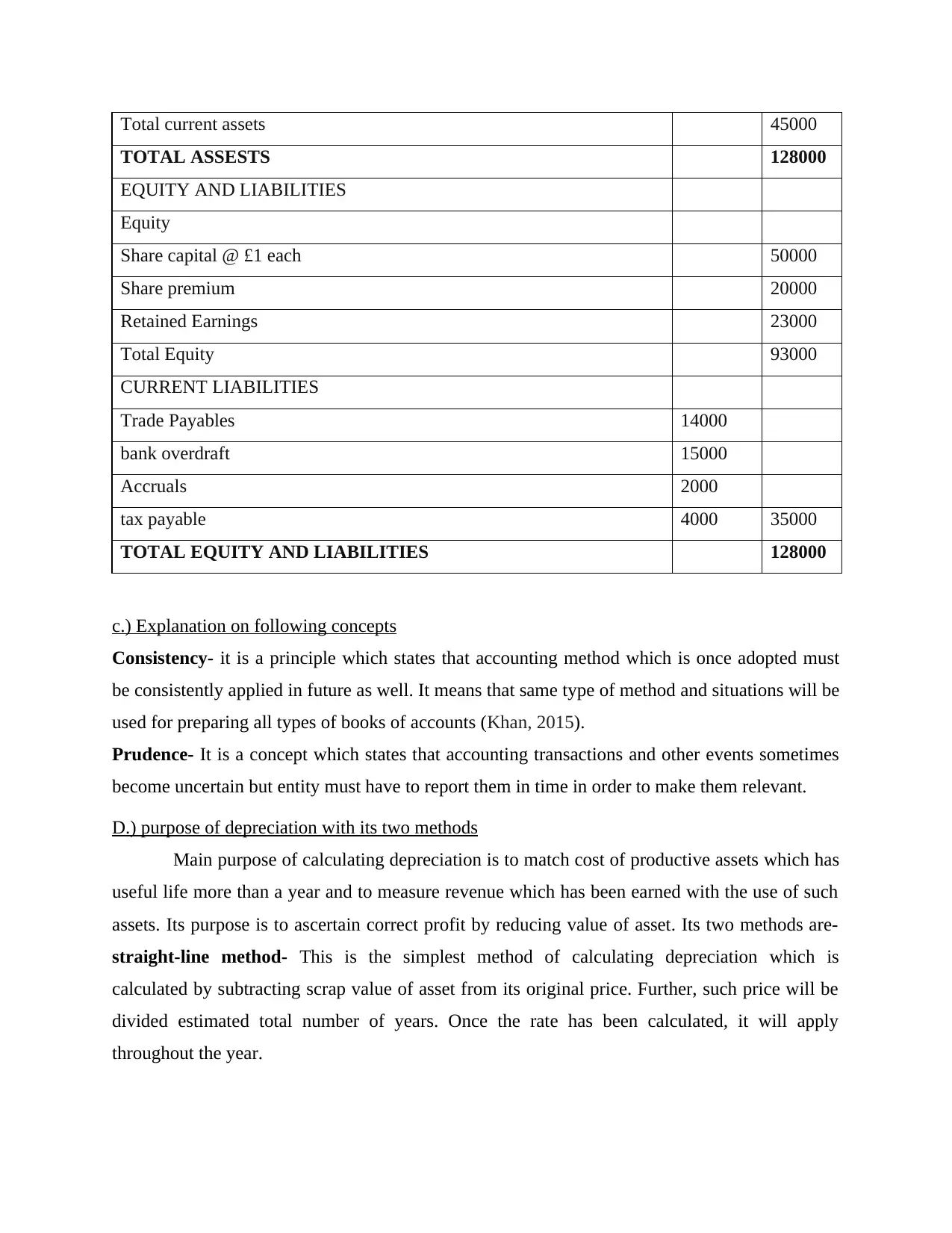
Total current assets 45000
TOTAL ASSESTS 128000
EQUITY AND LIABILITIES
Equity
Share capital @ £1 each 50000
Share premium 20000
Retained Earnings 23000
Total Equity 93000
CURRENT LIABILITIES
Trade Payables 14000
bank overdraft 15000
Accruals 2000
tax payable 4000 35000
TOTAL EQUITY AND LIABILITIES 128000
c.) Explanation on following concepts
Consistency- it is a principle which states that accounting method which is once adopted must
be consistently applied in future as well. It means that same type of method and situations will be
used for preparing all types of books of accounts (Khan, 2015).
Prudence- It is a concept which states that accounting transactions and other events sometimes
become uncertain but entity must have to report them in time in order to make them relevant.
D.) purpose of depreciation with its two methods
Main purpose of calculating depreciation is to match cost of productive assets which has
useful life more than a year and to measure revenue which has been earned with the use of such
assets. Its purpose is to ascertain correct profit by reducing value of asset. Its two methods are-
straight-line method- This is the simplest method of calculating depreciation which is
calculated by subtracting scrap value of asset from its original price. Further, such price will be
divided estimated total number of years. Once the rate has been calculated, it will apply
throughout the year.
TOTAL ASSESTS 128000
EQUITY AND LIABILITIES
Equity
Share capital @ £1 each 50000
Share premium 20000
Retained Earnings 23000
Total Equity 93000
CURRENT LIABILITIES
Trade Payables 14000
bank overdraft 15000
Accruals 2000
tax payable 4000 35000
TOTAL EQUITY AND LIABILITIES 128000
c.) Explanation on following concepts
Consistency- it is a principle which states that accounting method which is once adopted must
be consistently applied in future as well. It means that same type of method and situations will be
used for preparing all types of books of accounts (Khan, 2015).
Prudence- It is a concept which states that accounting transactions and other events sometimes
become uncertain but entity must have to report them in time in order to make them relevant.
D.) purpose of depreciation with its two methods
Main purpose of calculating depreciation is to match cost of productive assets which has
useful life more than a year and to measure revenue which has been earned with the use of such
assets. Its purpose is to ascertain correct profit by reducing value of asset. Its two methods are-
straight-line method- This is the simplest method of calculating depreciation which is
calculated by subtracting scrap value of asset from its original price. Further, such price will be
divided estimated total number of years. Once the rate has been calculated, it will apply
throughout the year.
Secure Best Marks with AI Grader
Need help grading? Try our AI Grader for instant feedback on your assignments.
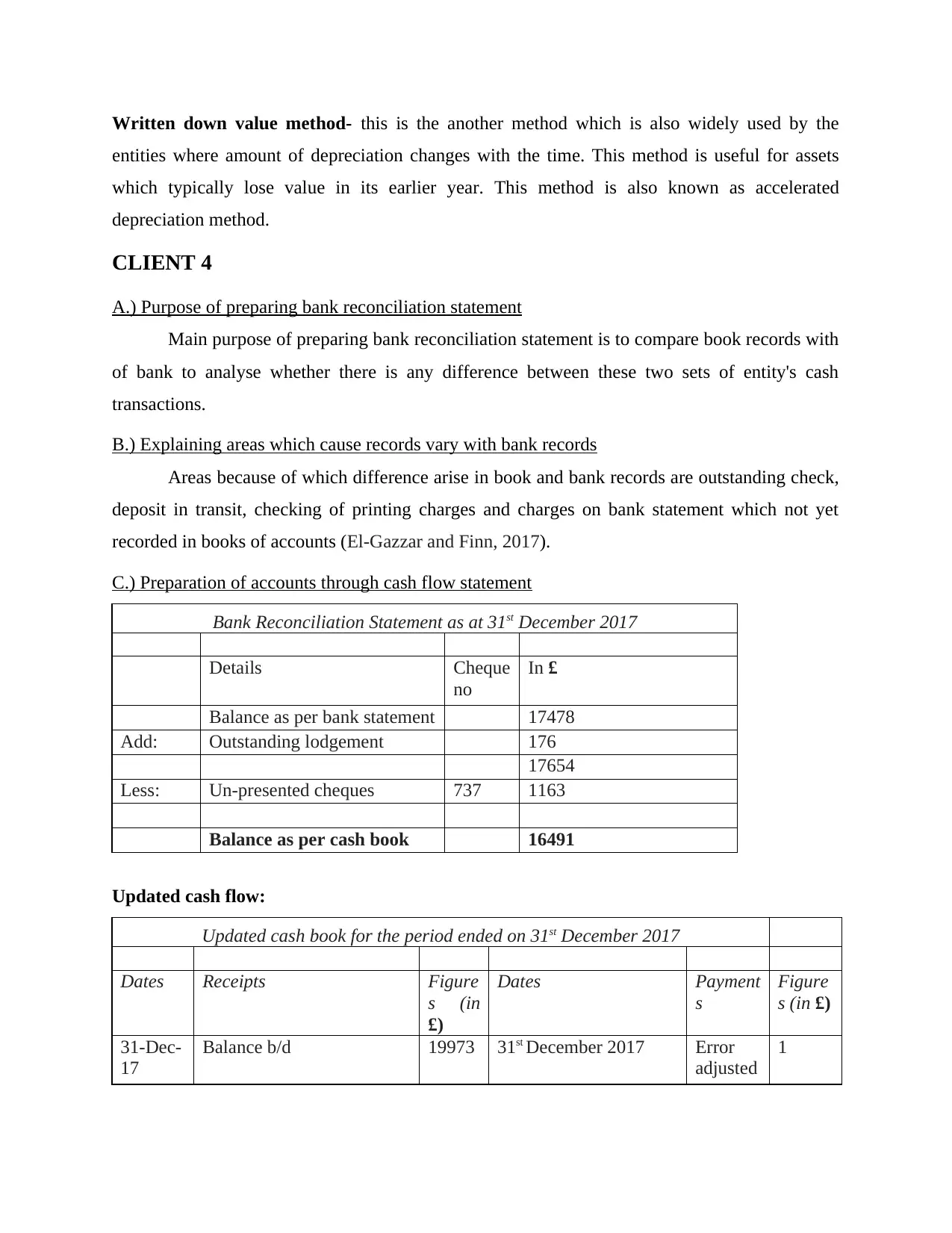
Written down value method- this is the another method which is also widely used by the
entities where amount of depreciation changes with the time. This method is useful for assets
which typically lose value in its earlier year. This method is also known as accelerated
depreciation method.
CLIENT 4
A.) Purpose of preparing bank reconciliation statement
Main purpose of preparing bank reconciliation statement is to compare book records with
of bank to analyse whether there is any difference between these two sets of entity's cash
transactions.
B.) Explaining areas which cause records vary with bank records
Areas because of which difference arise in book and bank records are outstanding check,
deposit in transit, checking of printing charges and charges on bank statement which not yet
recorded in books of accounts (El-Gazzar and Finn, 2017).
C.) Preparation of accounts through cash flow statement
Bank Reconciliation Statement as at 31st December 2017
Details Cheque
no
In £
Balance as per bank statement 17478
Add: Outstanding lodgement 176
17654
Less: Un-presented cheques 737 1163
Balance as per cash book 16491
Updated cash flow:
Updated cash book for the period ended on 31st December 2017
Dates Receipts Figure
s (in
£)
Dates Payment
s
Figure
s (in £)
31-Dec-
17
Balance b/d 19973 31st December 2017 Error
adjusted
1
entities where amount of depreciation changes with the time. This method is useful for assets
which typically lose value in its earlier year. This method is also known as accelerated
depreciation method.
CLIENT 4
A.) Purpose of preparing bank reconciliation statement
Main purpose of preparing bank reconciliation statement is to compare book records with
of bank to analyse whether there is any difference between these two sets of entity's cash
transactions.
B.) Explaining areas which cause records vary with bank records
Areas because of which difference arise in book and bank records are outstanding check,
deposit in transit, checking of printing charges and charges on bank statement which not yet
recorded in books of accounts (El-Gazzar and Finn, 2017).
C.) Preparation of accounts through cash flow statement
Bank Reconciliation Statement as at 31st December 2017
Details Cheque
no
In £
Balance as per bank statement 17478
Add: Outstanding lodgement 176
17654
Less: Un-presented cheques 737 1163
Balance as per cash book 16491
Updated cash flow:
Updated cash book for the period ended on 31st December 2017
Dates Receipts Figure
s (in
£)
Dates Payment
s
Figure
s (in £)
31-Dec-
17
Balance b/d 19973 31st December 2017 Error
adjusted
1
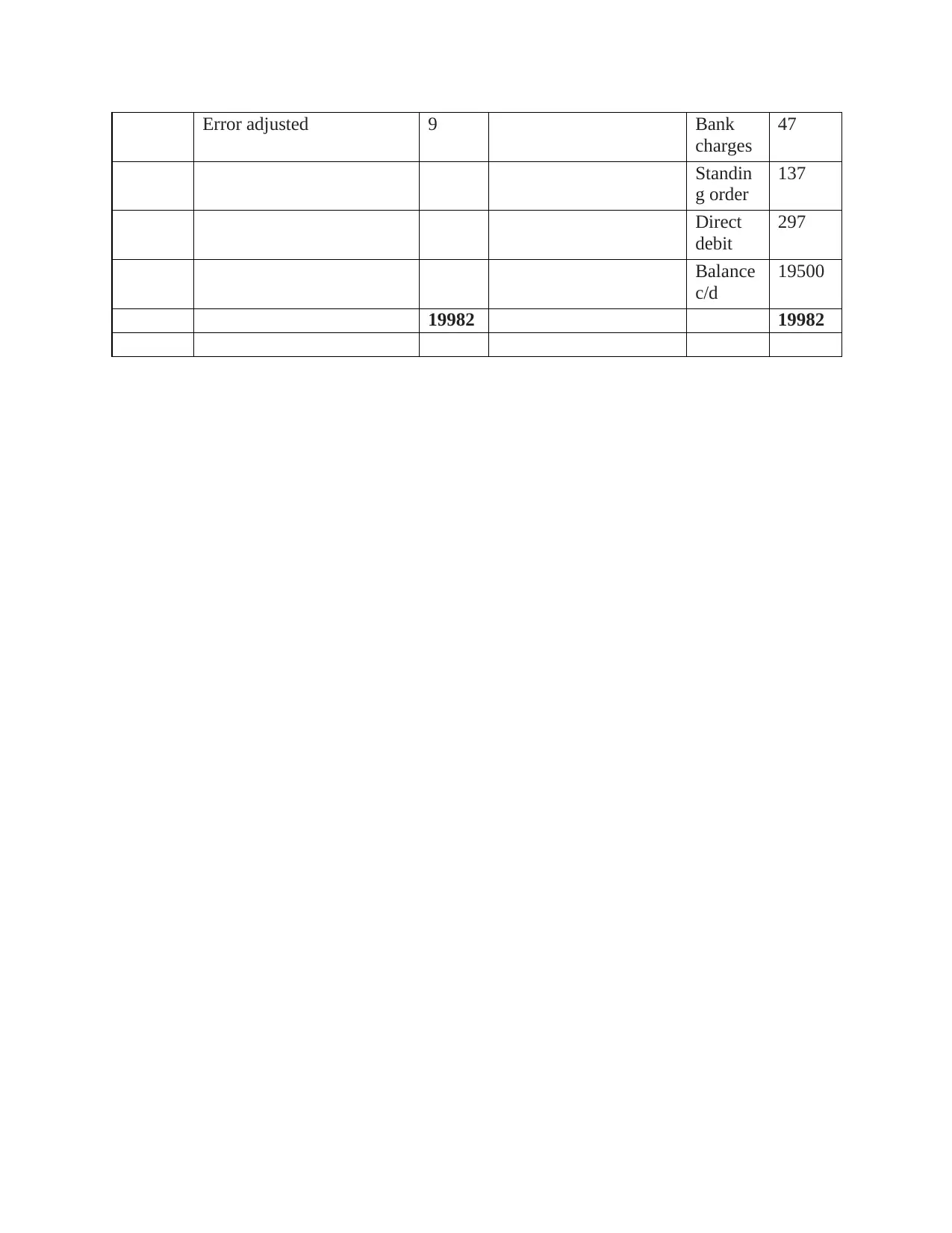
Error adjusted 9 Bank
charges
47
Standin
g order
137
Direct
debit
297
Balance
c/d
19500
19982 19982
charges
47
Standin
g order
137
Direct
debit
297
Balance
c/d
19500
19982 19982
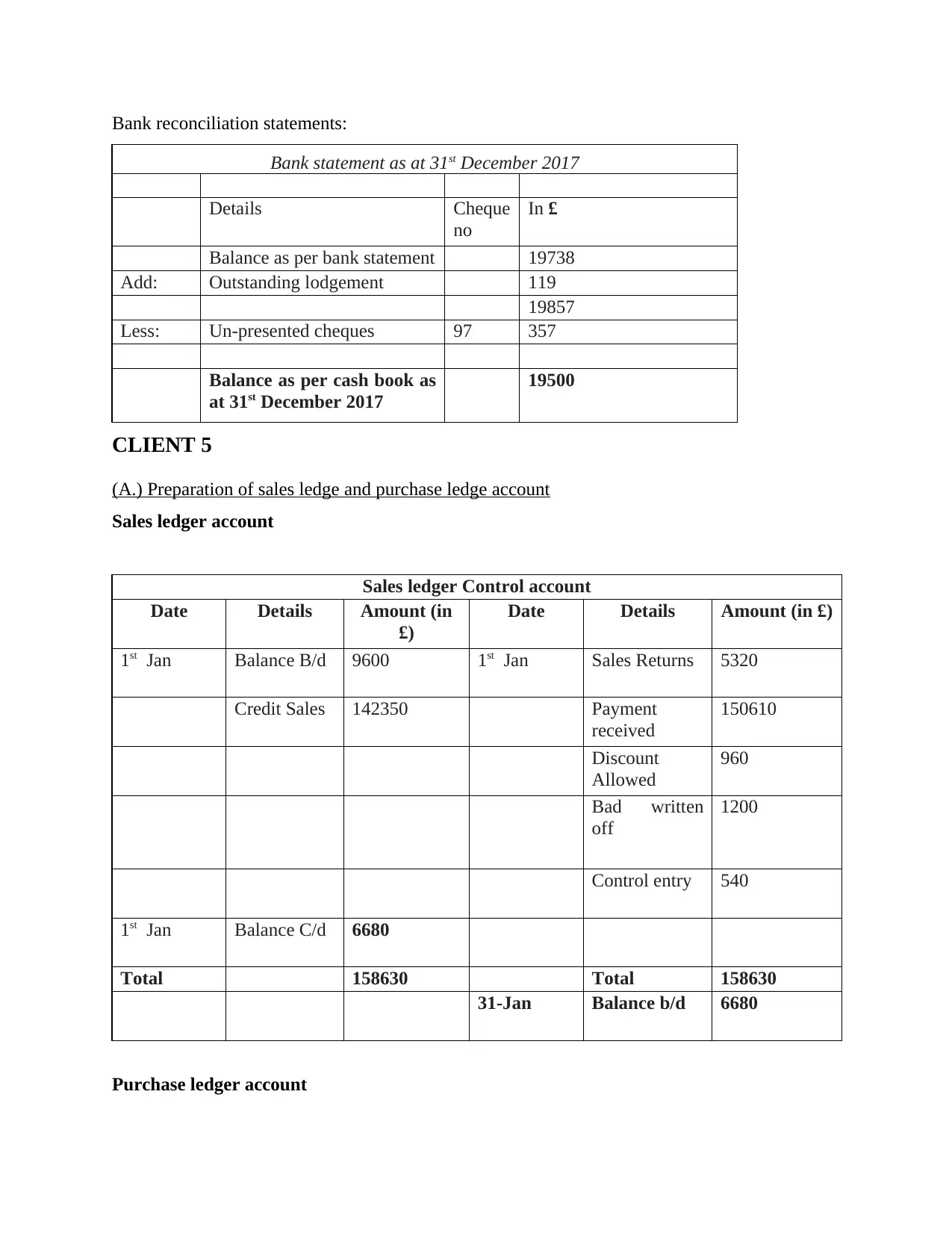
Bank reconciliation statements:
Bank statement as at 31st December 2017
Details Cheque
no
In £
Balance as per bank statement 19738
Add: Outstanding lodgement 119
19857
Less: Un-presented cheques 97 357
Balance as per cash book as
at 31st December 2017
19500
CLIENT 5
(A.) Preparation of sales ledge and purchase ledge account
Sales ledger account
Sales ledger Control account
Date Details Amount (in
£)
Date Details Amount (in £)
1st Jan Balance B/d 9600 1st Jan Sales Returns 5320
Credit Sales 142350 Payment
received
150610
Discount
Allowed
960
Bad written
off
1200
Control entry 540
1st Jan Balance C/d 6680
Total 158630 Total 158630
31-Jan Balance b/d 6680
Purchase ledger account
Bank statement as at 31st December 2017
Details Cheque
no
In £
Balance as per bank statement 19738
Add: Outstanding lodgement 119
19857
Less: Un-presented cheques 97 357
Balance as per cash book as
at 31st December 2017
19500
CLIENT 5
(A.) Preparation of sales ledge and purchase ledge account
Sales ledger account
Sales ledger Control account
Date Details Amount (in
£)
Date Details Amount (in £)
1st Jan Balance B/d 9600 1st Jan Sales Returns 5320
Credit Sales 142350 Payment
received
150610
Discount
Allowed
960
Bad written
off
1200
Control entry 540
1st Jan Balance C/d 6680
Total 158630 Total 158630
31-Jan Balance b/d 6680
Purchase ledger account
Paraphrase This Document
Need a fresh take? Get an instant paraphrase of this document with our AI Paraphraser
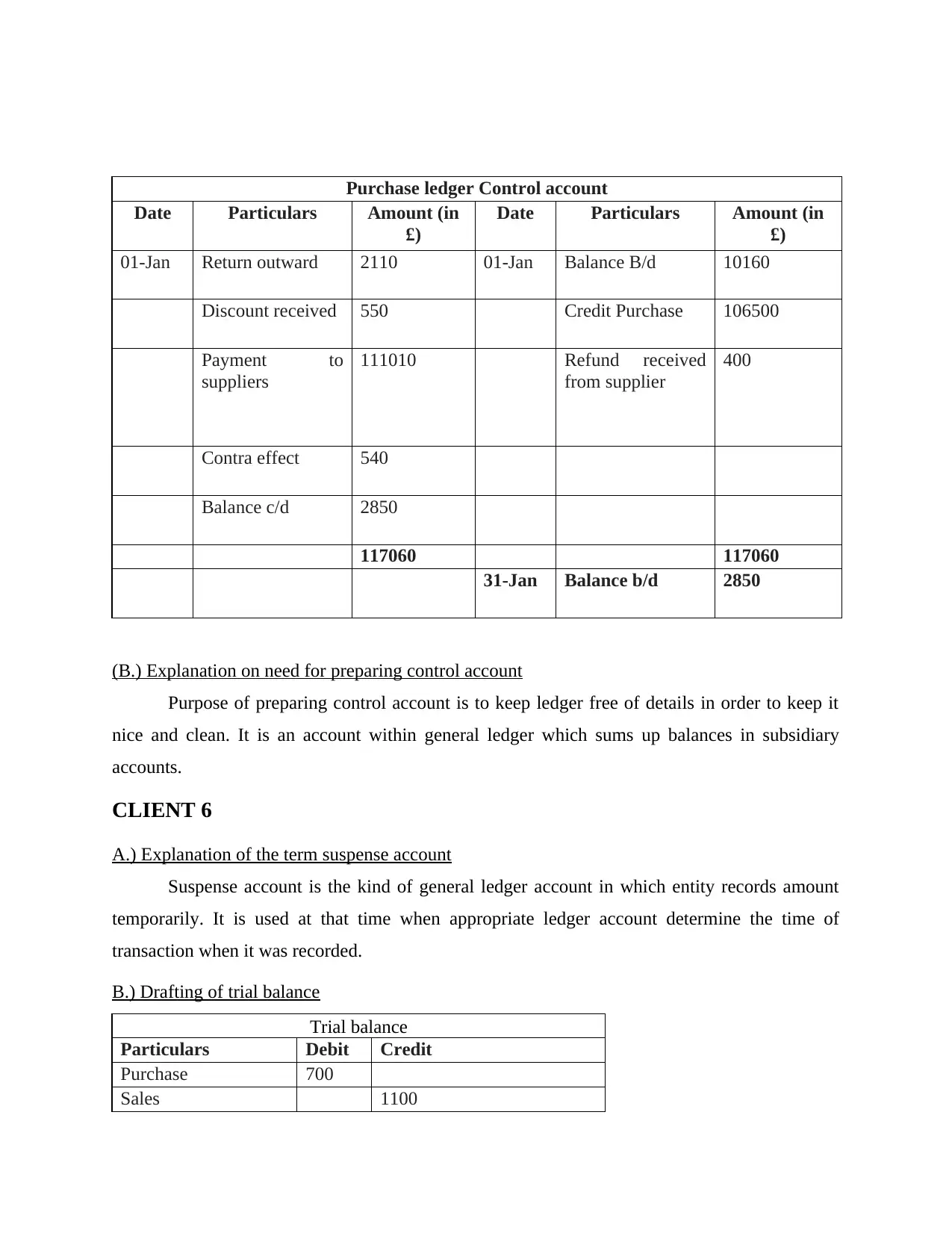
Purchase ledger Control account
Date Particulars Amount (in
£)
Date Particulars Amount (in
£)
01-Jan Return outward 2110 01-Jan Balance B/d 10160
Discount received 550 Credit Purchase 106500
Payment to
suppliers
111010 Refund received
from supplier
400
Contra effect 540
Balance c/d 2850
117060 117060
31-Jan Balance b/d 2850
(B.) Explanation on need for preparing control account
Purpose of preparing control account is to keep ledger free of details in order to keep it
nice and clean. It is an account within general ledger which sums up balances in subsidiary
accounts.
CLIENT 6
A.) Explanation of the term suspense account
Suspense account is the kind of general ledger account in which entity records amount
temporarily. It is used at that time when appropriate ledger account determine the time of
transaction when it was recorded.
B.) Drafting of trial balance
Trial balance
Particulars Debit Credit
Purchase 700
Sales 1100
Date Particulars Amount (in
£)
Date Particulars Amount (in
£)
01-Jan Return outward 2110 01-Jan Balance B/d 10160
Discount received 550 Credit Purchase 106500
Payment to
suppliers
111010 Refund received
from supplier
400
Contra effect 540
Balance c/d 2850
117060 117060
31-Jan Balance b/d 2850
(B.) Explanation on need for preparing control account
Purpose of preparing control account is to keep ledger free of details in order to keep it
nice and clean. It is an account within general ledger which sums up balances in subsidiary
accounts.
CLIENT 6
A.) Explanation of the term suspense account
Suspense account is the kind of general ledger account in which entity records amount
temporarily. It is used at that time when appropriate ledger account determine the time of
transaction when it was recorded.
B.) Drafting of trial balance
Trial balance
Particulars Debit Credit
Purchase 700
Sales 1100
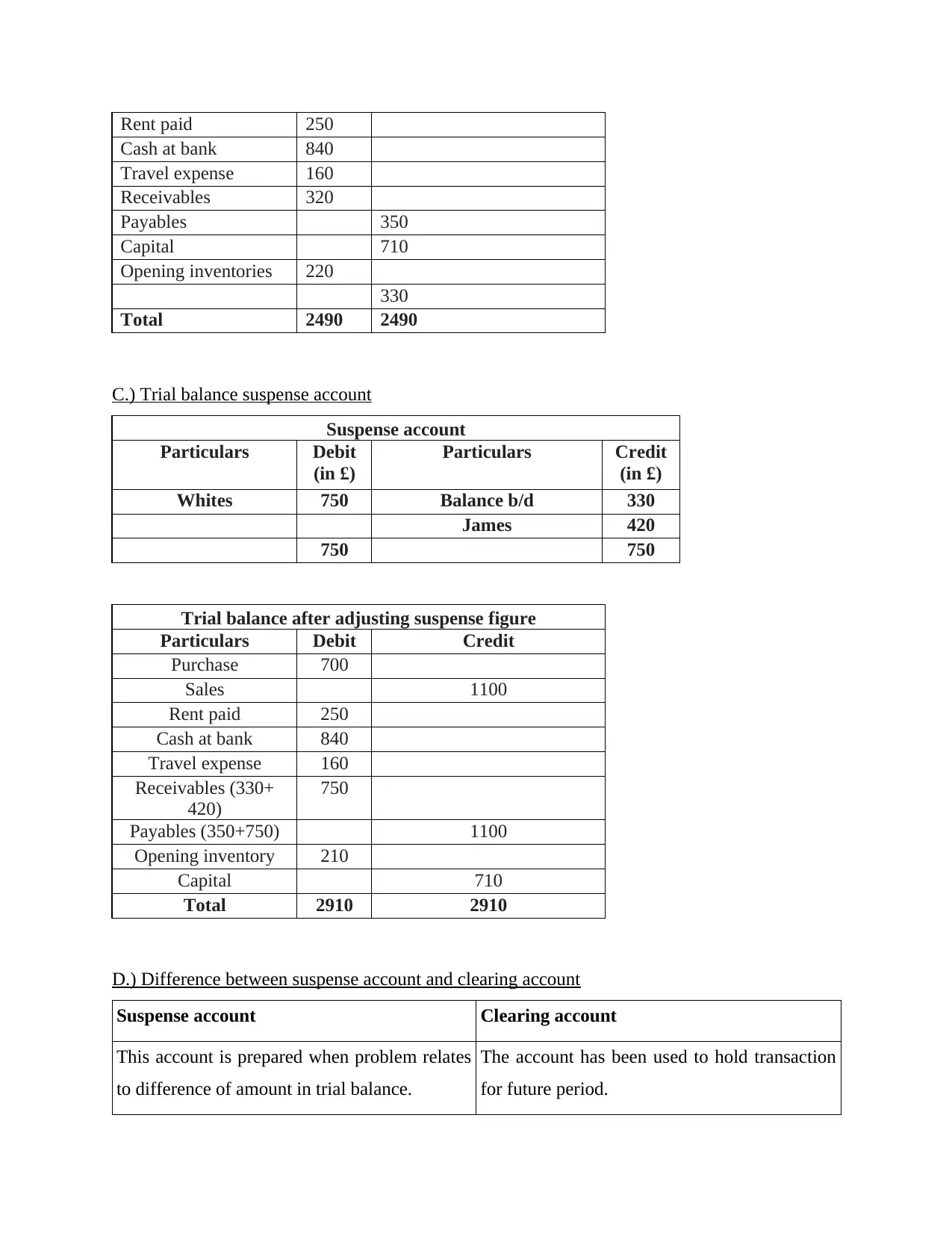
Rent paid 250
Cash at bank 840
Travel expense 160
Receivables 320
Payables 350
Capital 710
Opening inventories 220
330
Total 2490 2490
C.) Trial balance suspense account
Suspense account
Particulars Debit
(in £)
Particulars Credit
(in £)
Whites 750 Balance b/d 330
James 420
750 750
Trial balance after adjusting suspense figure
Particulars Debit Credit
Purchase 700
Sales 1100
Rent paid 250
Cash at bank 840
Travel expense 160
Receivables (330+
420)
750
Payables (350+750) 1100
Opening inventory 210
Capital 710
Total 2910 2910
D.) Difference between suspense account and clearing account
Suspense account Clearing account
This account is prepared when problem relates
to difference of amount in trial balance.
The account has been used to hold transaction
for future period.
Cash at bank 840
Travel expense 160
Receivables 320
Payables 350
Capital 710
Opening inventories 220
330
Total 2490 2490
C.) Trial balance suspense account
Suspense account
Particulars Debit
(in £)
Particulars Credit
(in £)
Whites 750 Balance b/d 330
James 420
750 750
Trial balance after adjusting suspense figure
Particulars Debit Credit
Purchase 700
Sales 1100
Rent paid 250
Cash at bank 840
Travel expense 160
Receivables (330+
420)
750
Payables (350+750) 1100
Opening inventory 210
Capital 710
Total 2910 2910
D.) Difference between suspense account and clearing account
Suspense account Clearing account
This account is prepared when problem relates
to difference of amount in trial balance.
The account has been used to hold transaction
for future period.
1 out of 27
Related Documents
Your All-in-One AI-Powered Toolkit for Academic Success.
+13062052269
info@desklib.com
Available 24*7 on WhatsApp / Email
![[object Object]](/_next/static/media/star-bottom.7253800d.svg)
Unlock your academic potential
© 2024 | Zucol Services PVT LTD | All rights reserved.





